Al-Andalus revisited
Eight centuries of Muslim rule in Spain, during which Arab culture and science flourished, are echoed not only in the magnificent art and buildings of Al-Andalus, but also in the souls and the DNA of its descendants

Never was the annihilation of a people more complete than that of the Morisco-Spaniards. Where are they? Ask the shores of Barbary and its desert places (where) the exiled remnant of their once powerful empire disappeared … The home of their adoption, and of their occupation for ages, refuses to acknowledge them, except as invaders and usurpers. A few broken monuments are all that remain to bear witness to their power and dominion, as solitary rocks, left far in the interior, bear testimony to the extent of some vast inundation. Such is the Alhambra … an Oriental palace amidst the Gothic edifices of the West; an elegant memento of a brave, intelligent, and graceful people, who conquered, ruled, flourished, and passed away.
Legend has it that as the last ruler of the Emirate of Granada rode away into exile in 1492, he halted his horse at a high point in the Sierra Nevada mountains, turned in the saddle and sighed as he gazed for the last time upon the distant Alhambra, the spectacular fortified palace that symbolized the wealth of cultural gems that eight centuries of Muslim occupation had left scattered across the landscape of Spanish identity.
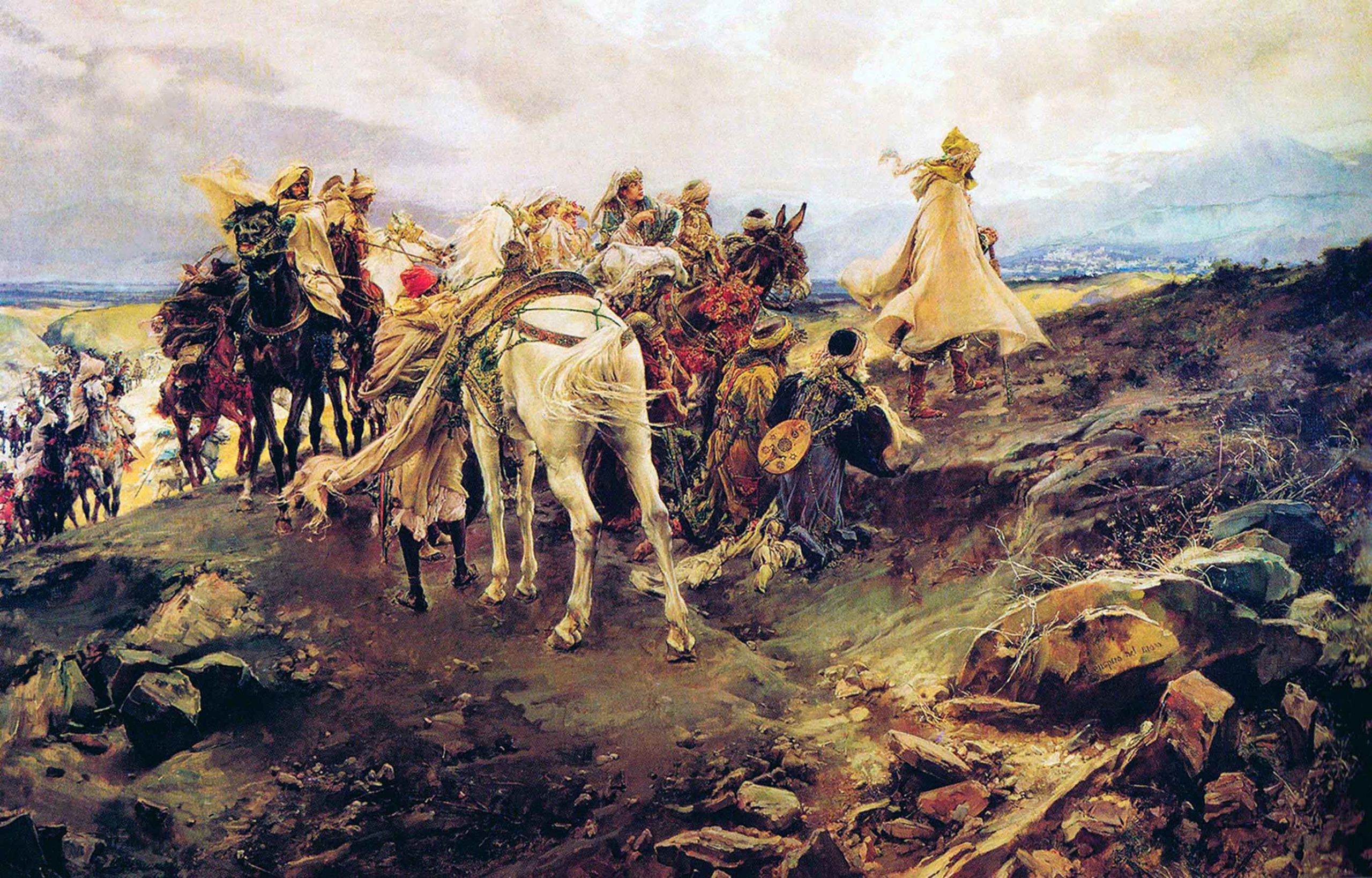
Nineteenth-century Spanish artist Francisco Pradilla Ortiz portrayed the mythical moment when a defeated Mohammed XII gazed back at the Alhambra for the last time. (Alamy)
Nineteenth-century Spanish artist Francisco Pradilla Ortiz portrayed the mythical moment when a defeated Mohammed XII gazed back at the Alhambra for the last time. (Alamy)
Well might Abu Abdallah Mohammed XII have sighed. His eviction by the armies of the Christian monarchs Isabella I of Castile and her husband Ferdinand II of Aragon brought to an end almost 800 years of Islamic rule in the Iberian Peninsula.
True or not, the story encapsulates the reality that the long Muslim domination of the land seized by the Umayyad caliphate in 711 and known to them as Al-Andalus left a rich heritage, evident today in the language, customs, architecture and even the genetic makeup of modern-day Spain.
In no single architectural presence is that heritage more evident than in the Alhambra, the complex of buildings that began life as a small Muslim fortress in about 889 and was renovated and expanded beyond all recognition in the mid-13th century by Mohammed ibn Yusuf ibn Nasr, the founder of the Emirate of Granada.
The Alhambra, like the Nasrid dynasty founded by Mohammed I, was fated to be the last and perhaps greatest flowering of Muslim influence in Iberia. The beauty of the palace complex and its surroundings, from the tranquil Court of the Lions to the Hall of the Abencerrajes, has been celebrated by writers and artists over the centuries.
Among the most spellbound of them was the American author and historian Washington Irving, who in the spring of 1829 traveled from Seville to Granada to see the fabled palace for himself.
Irving and his traveling companion, a diplomat from the Russian embassy in Madrid, were granted the privilege of staying in the Alhambra, in the deserted quarters of the absent governor.
There, they slept on the floor, spending their days exploring every corner of the great complex and their nights listening for the whisperings of the ghosts that every local believed inhabited it.
It is clear from “Tales of the Alhambra,” Irving’s account of his visit published in 1832, that the writer immediately fell under the spell of the place.
“To the traveller imbued with a feeling for the historical and poetical, so inseparably intertwined in the annals of romantic Spain,” he wrote, “the Alhambra is … an object of devotion.”
This, he added, was “the royal abode” of the Muslim rulers, where, “surrounded with the splendors and refinements of Asiatic luxury, they held dominion over what they vaunted as a terrestrial paradise, and made their last stand for empire in Spain.”
The Court of the Lions in particular seized Irving’s imagination. “No part of the complex gives a more complete idea of its original beauty than this, for none has suffered so little from the ravages of time,” he wrote.
“In the center stands the fountain famous in song and story. The alabaster basins still shed their diamond drops; the twelve lions which support them, and give the court its name, still cast forth crystal streams as in the days of Boabdil” — the Spanish derivation of Mohammed XII’s name, Abu Abdallah.
In “Tales of the Alhambra,” the poet and historian within Irving joined forces in an appreciation not only of the Alhambra but also of the great enterprise that was 800 years of Muslim rule in Iberia.
The Muslims, wrote Irving, had “sought to establish in Spain a peaceful and permanent dominion. As conquerors, their heroism was only equalled by their moderation; and in both, for a time, they excelled the nations with whom they contended.”
Laying the foundations of their power “in a system of wise and equitable laws, diligently cultivating the arts and sciences, and promoting agriculture, manufactures, and commerce; they gradually formed an empire unrivalled for its prosperity by any of the empires of Christendom; and diligently drawing round them the graces and refinements which marked the Arabian empire in the East, at the time of its greatest civilization, they diffused the light of Oriental knowledge, through the Western regions of benighted Europe.”
The cities of Arabian Spain, as Irving noted, “became the resort of Christian artisans, to instruct themselves in the useful arts. The universities of Toledo, Cordoba, Seville, and Granada, were sought by the pale student from other lands to acquaint himself with the sciences of the Arabs, and the treasured lore of antiquity.”
Others came to Cordoba and Granada, “to imbibe the poetry and music of the East; and the steel-clad warriors of the North hastened thither to accomplish themselves in the graceful exercises and courteous usages of chivalry.”
Irving’s “serene and happy reign in the Alhambra” was “suddenly brought to a close by letters which reached me, while indulging in Oriental luxury in the cool hall of the baths, summoning me away from my Muslim elysium to mingle once more in the bustle and business of the dusty world.”
How, he wondered, “was I to encounter its toils and turmoils, after such a life of repose and reverie! How was I to endure its common-place, after the poetry of the Alhambra!”
His last thought as he left the Alhambra behind was of the torment that must have been suffered 340 years earlier by Mohammed XII. “Towards sunset I came to where the road wound into the mountains, and here I paused to take a last look at Granada,” wrote Irving.
I could now realize something of the feelings of poor Boabdil when he bade adieu to the paradise he was leaving behind, and beheld before him a rugged and sterile road conducting him to exile.
“The hill on which I stood commanded a glorious view of the city, the Vega, and the surrounding mountains … I now could realize something of the feelings of poor Boabdil when he bade adieu to the paradise he was leaving behind, and beheld before him a rugged and sterile road conducting him to exile.”
The story of Boabdil’s “last sigh,” supposedly uttered as he gazed back at the Alhambra, reflects centuries of portrayal of Mohammed XII in the West as a weak, vain ruler incapable of resisting the Christians. In fact, as modern historians now recognize, Boabdil was a brave, shrewd man who, in the view of his most recent biographer, knew when the time had come to choose surrender over the further suffering of his people.
“What makes Boabdil a hero for today is that he always took the path of peace and negotiation if he possibly could,” Cambridge historian Elizabeth Drayson told Arab News. “He wasn’t frightened to fight — he was known to be a courageous fighter — but he went for reconciliation whenever possible.”
But in a short time, the Christians would betray the terms of his surrender, which had allowed for the Muslims, Christians and Jews of Iberia to live peacefully alongside each other in the land they knew as Al-Andalus.
The Jews were the first to be expelled, almost as soon as their Muslim king had ridden away into exile. Then, in 1502, all Muslims were ordered to convert to Christianity or face exile.
A century later, the so-called “Moriscos,” the descendants of those who had chosen to convert, were expelled by King Philip III of Spain.
Today, a handful of people who claim descendancy from the original Muslims of Al-Andalus can be found scattered across the lands of the former medieval Islamic caliphates of North Africa and in Spain itself. They are the last of the Andalusians, and this is their story.
The rise of Al-Andalus
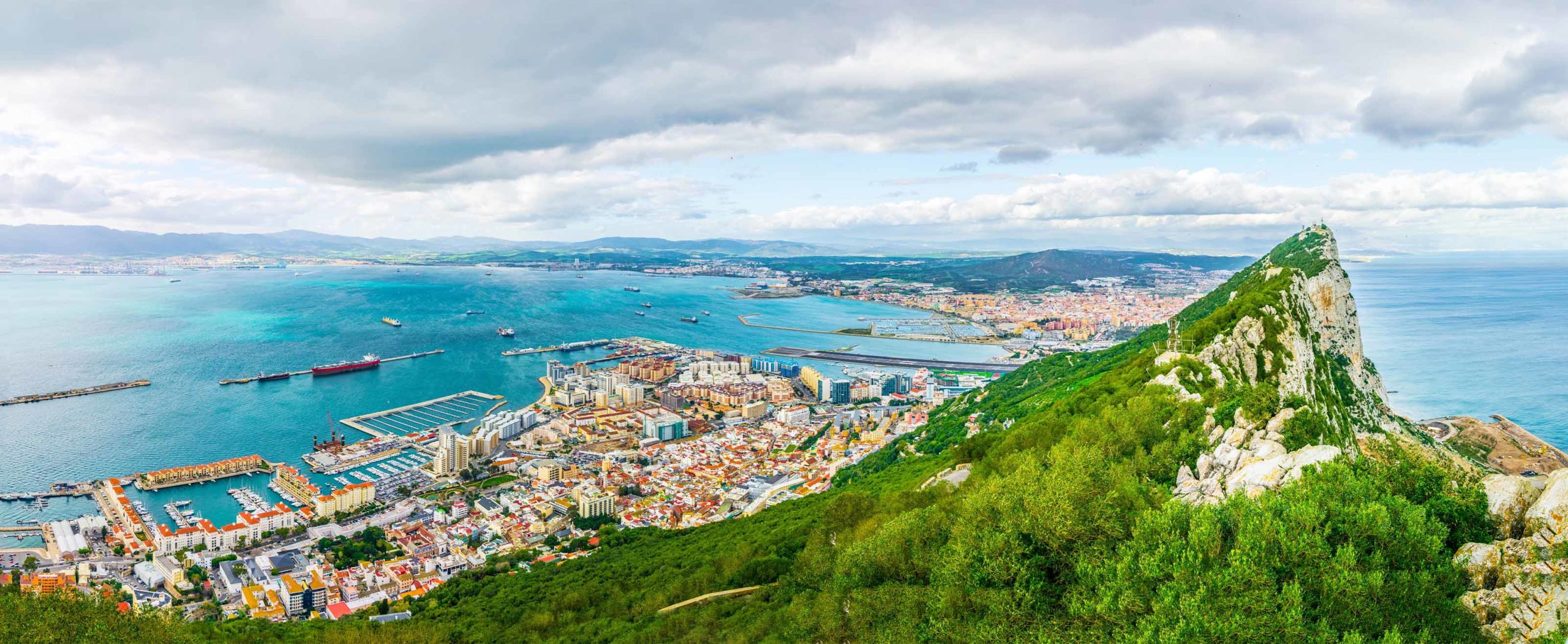
In 1995, the British overseas territory of Gibraltar — an affront to Spanish national pride ever since the rocky outcrop that guards the entrance to the Mediterranean was seized by Britain in 1704 — published a series of banknotes commemorating four men central to the history of the outpost.
Three were fairly predictable: General George Eliott, the governor who held out against a joint Spanish-French siege between 1779 and 1783; Admiral Horatio Nelson, whose body was borne back to Gibraltar on HMS Victory following his defeat of the French fleet at the Battle of Trafalgar in 1805; and British leader Winston Churchill, for whom Gibraltar served as a vital refuge for Royal Navy warships during the Second World War.
And then, wearing a turban, clutching a scimitar and gazing out haughtily from the back of the £5 note, there was the eighth-century Muslim warrior Tariq ibn Ziyad.
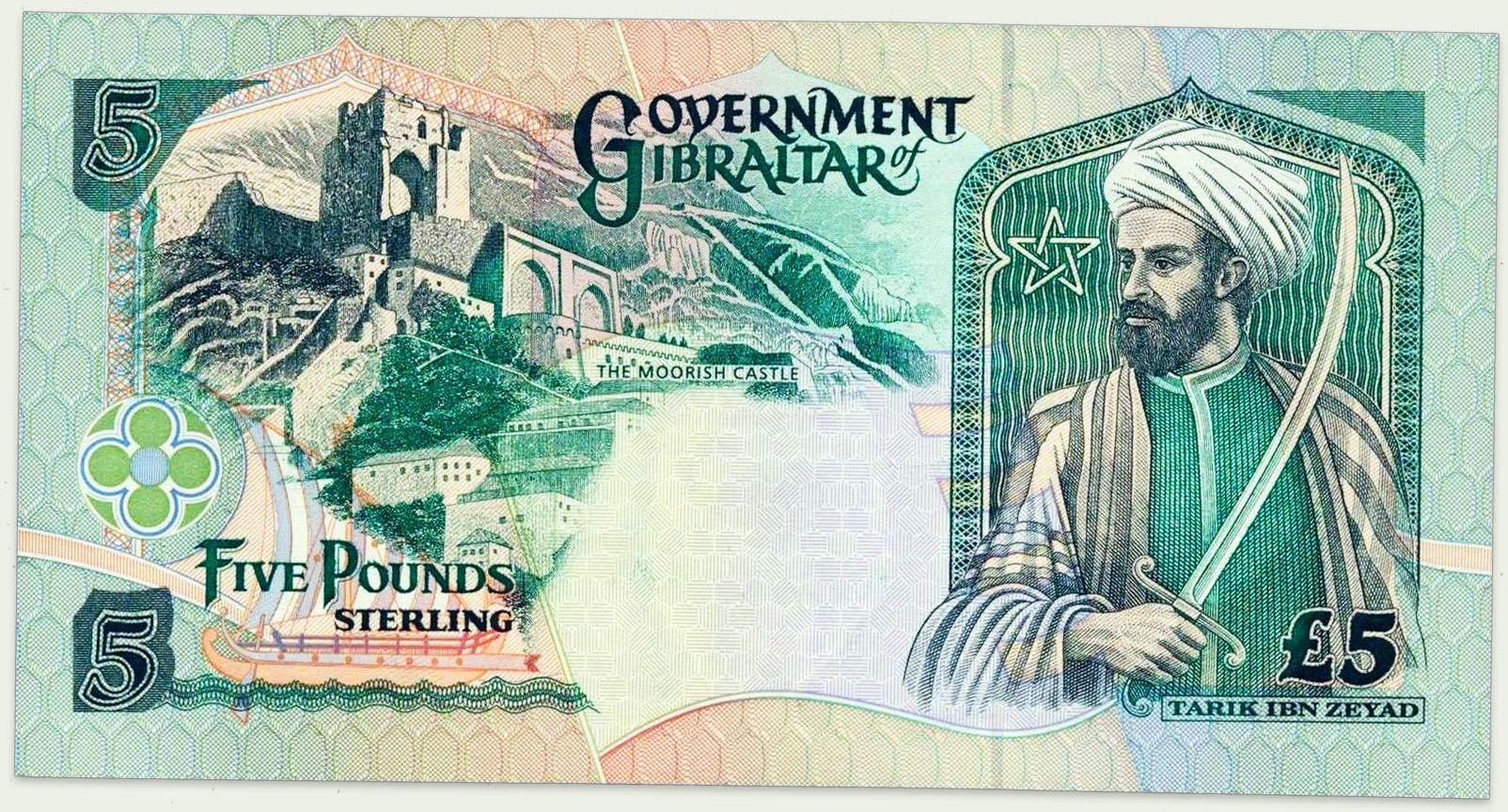
A £5 note carries the portrait of Tariq ibn Ziyad gazing over Jabal Tariq, named after him and from which Gibraltar got its name. (worldbanknotescoins.com)
It’s hard to resist the conclusion that Tariq, the man whose feat of arms in 711 swept the Christian Visigoths out of Iberia, paving the way for 800 years of Muslim rule, was included in the line-up solely for the purpose of antagonizing the Spanish.
But of the four it was Tariq, the Umayyad caliphate’s governor of Tangier, whose actions have had the greatest historical impact, not only on Spain, with its frequently denied but ultimately inescapable Islamic heritage, but also on the whole of Western thought, art and science.
It is unlikely that Tariq himself foresaw such a far-reaching outcome when, in the spring of 711, he was ordered by Musa ibn Nusayr, the Umayyad governor of North Africa, to lead an army of 7,000 Berbers and Arabs on an expedition to the southern coast of Spain.
But it is a measure of the impact Tariq was to have on history that the rock where he landed his army was known henceforth in Arabic as Jabal Tariq, the Mountain of Tariq, a name that has survived down to modern times as Gibraltar.
The Muslims did not simply turn up out of the blue in 711. Trade between North Africa and southern Iberia had been going on for many centuries.
The Muslims did not simply turn up out of the blue in 711. Trade between North Africa and southern Iberia had been going on for many centuries. Sailing due north, it is only 20 kilometers from Ceuta on the northernmost point of Morocco to Gibraltar which, on a clear day, can be seen clearly from the African coast.
Until 711, the Visigoths, the Germanic people who had occupied Iberia since the sixth century, had even had a trading outpost at Ceuta. The Visigoths, originally Arian Christians who over time had converted to Catholicism, had only their internal squabbling to blame for the disaster that overtook them. When King Roderick, the last Visigothic king, seized the throne in 710, his rivals sought allies among the Muslims of North Africa, and in 711 Musa ibn Nusayr dispatched Tariq on his historic mission.
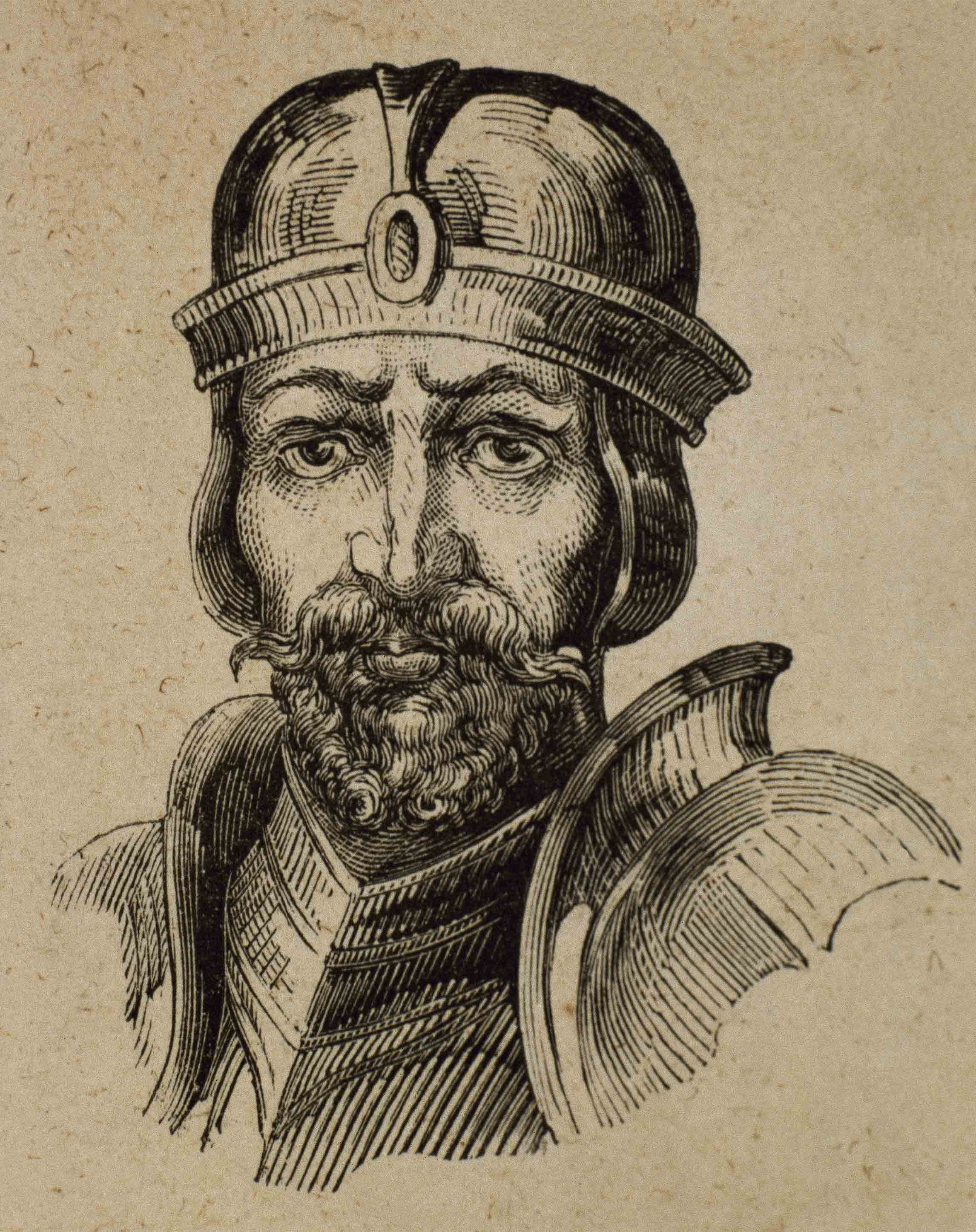
An engraving of Roderick, the last Visigothic king in Iberia, who seized the throne in 710 but was killed in battle with Tariq ibn Ziyad the following year. (Getty Images)
In his book “The Breath of Perfume,” the 17th-century Algerian historian Ahmad ibn Mohammed Al-Maqqari included a passage purporting to be Tariq’s address to his soldiers on the eve of battle. “Oh, my warriors,” he is reported to have said, “whither would you flee? Behind you is the sea, before you, the enemy. You have left now only the hope of your courage and your constancy.
“Your enemy is … protected by an innumerable army; he has men in abundance, but you, as your only aid, have your own swords, and, as your only chance for life, such chance as you can snatch from the hands of your enemy.”
And snatch it they did.
Tariq first quickly captured Algeciras on the bay of Gibraltar. When the news reached King Roderick, who was busy suppressing a revolt in the north of his territory, he hurried south with an army some chroniclers claim was 30,000 strong — more than four times larger than Tariq’s force.
Exactly where the two sides met is not clear, but at a battle fought somewhere near the Guadalete River in the south of Spain, the Visigoths were routed and Roderick was killed. It was the end of the Visigothic empire and the dawn of the age of Al-Andalus.

A £5 note carries the portrait of Tariq ibn Ziyad gazing over Jabal Tariq, named after him and from which Gibraltar got its name. (worldbanknotescoins.com)
A £5 note carries the portrait of Tariq ibn Ziyad gazing over Jabal Tariq, named after him and from which Gibraltar got its name. (worldbanknotescoins.com)

An engraving of Roderick, the last Visigothic king in Iberia, who seized the throne in 710 but was killed in battle with Tariq ibn Ziyad the following year. (Getty Images)
An engraving of Roderick, the last Visigothic king in Iberia, who seized the throne in 710 but was killed in battle with Tariq ibn Ziyad the following year. (Getty Images)
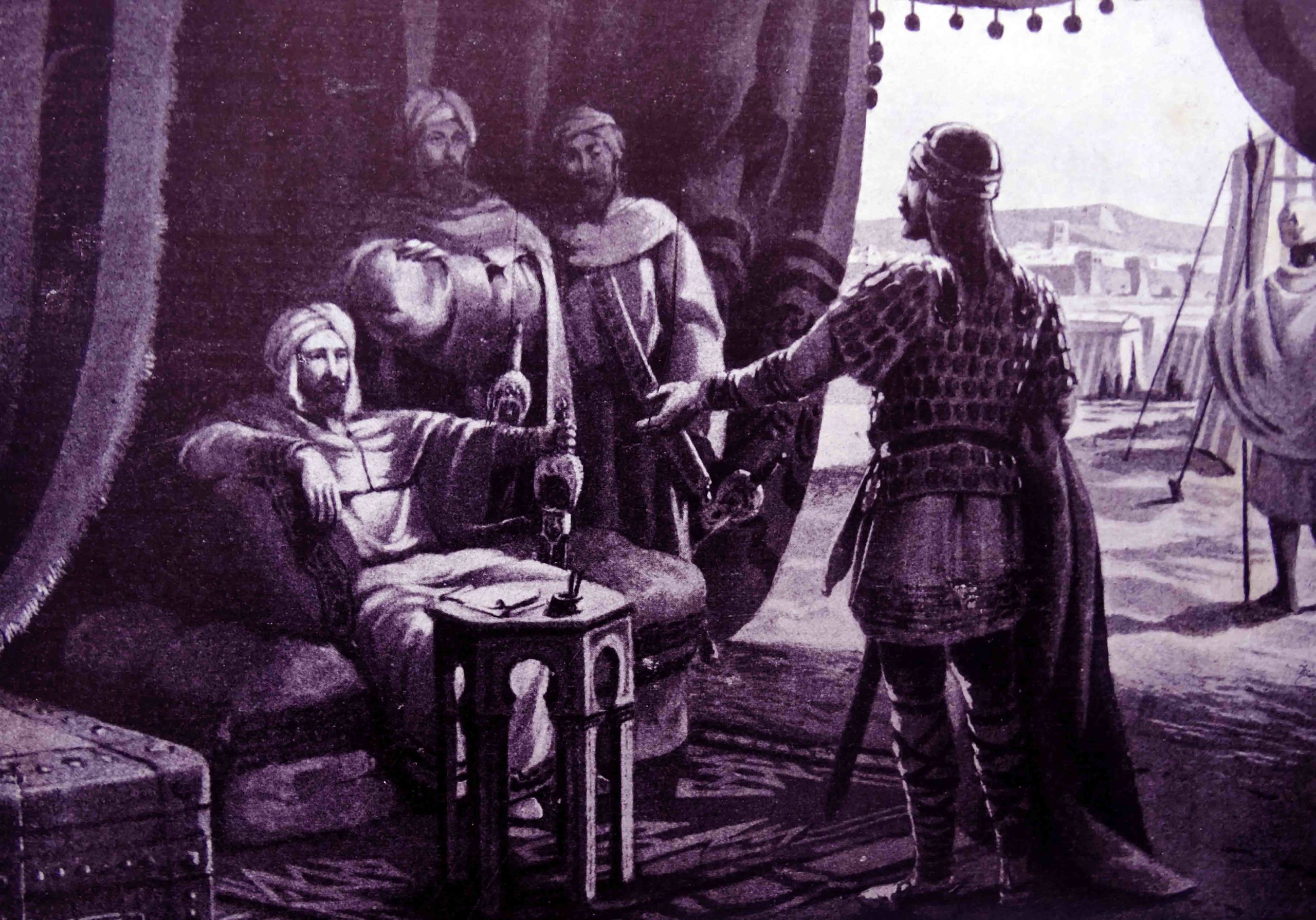
Abd Al-Aziz, the son of Musa ibn Nusayr, was installed as the first governor of Al-Andalus in 715. (Getty Images)
Abd Al-Aziz, the son of Musa ibn Nusayr, was installed as the first governor of Al-Andalus in 715. (Getty Images)
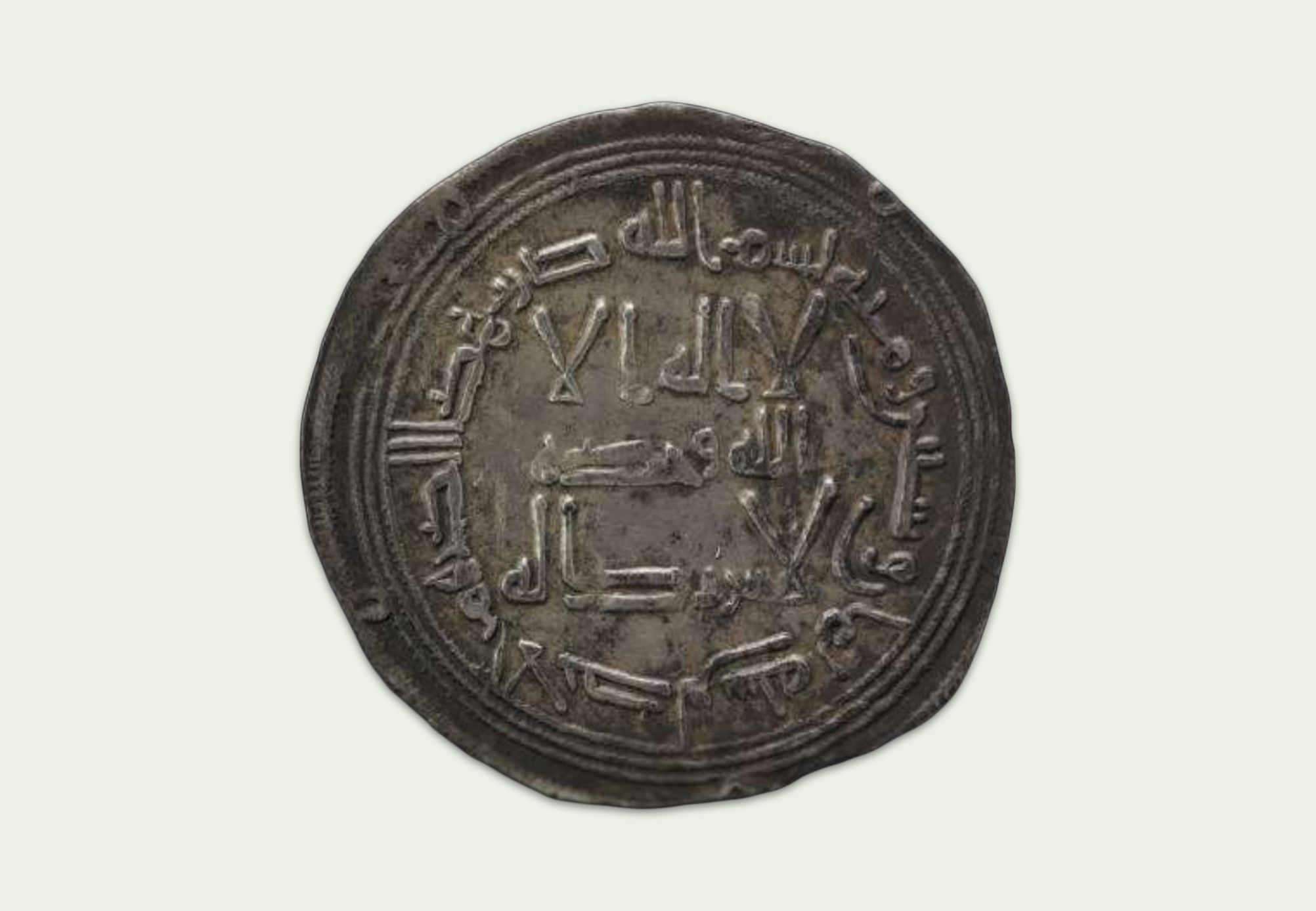
The name “Al-Andalus” first appears in writing on coins, such as this one, which includes the inscription: "In the name of God, this dirham was minted in Al-Andalus in the year 168" – about 784 in the Gregorian calendar. (British Museum)
The name “Al-Andalus” first appears in writing on coins, such as this one, which includes the inscription: "In the name of God, this dirham was minted in Al-Andalus in the year 168" – about 784 in the Gregorian calendar. (British Museum)
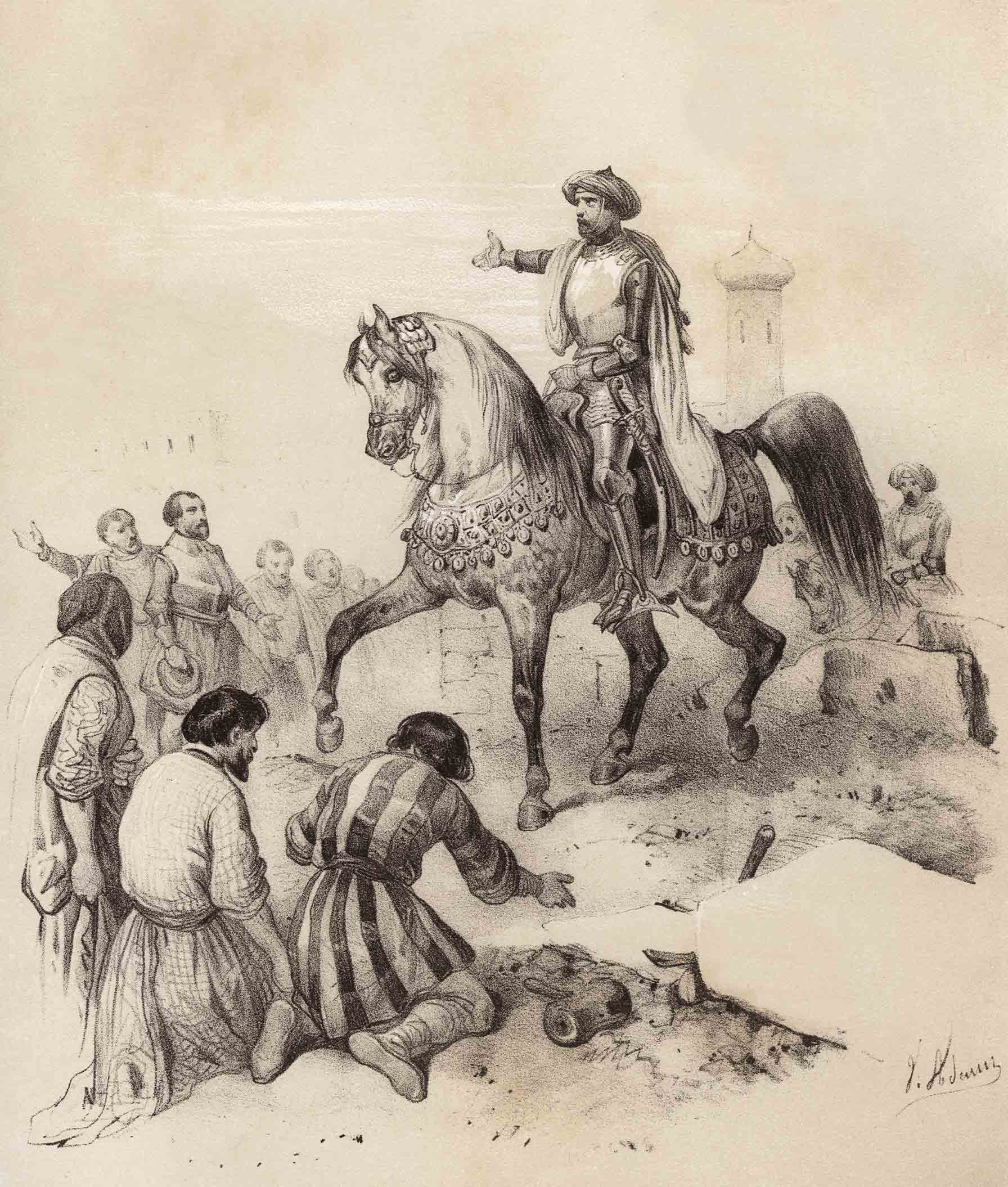
A lithograph depicting Abd Al-Rahman I, who founded the Umayyad Emirate of Cordoba in 756. (Getty Images)
A lithograph depicting Abd Al-Rahman I, who founded the Umayyad Emirate of Cordoba in 756. (Getty Images)
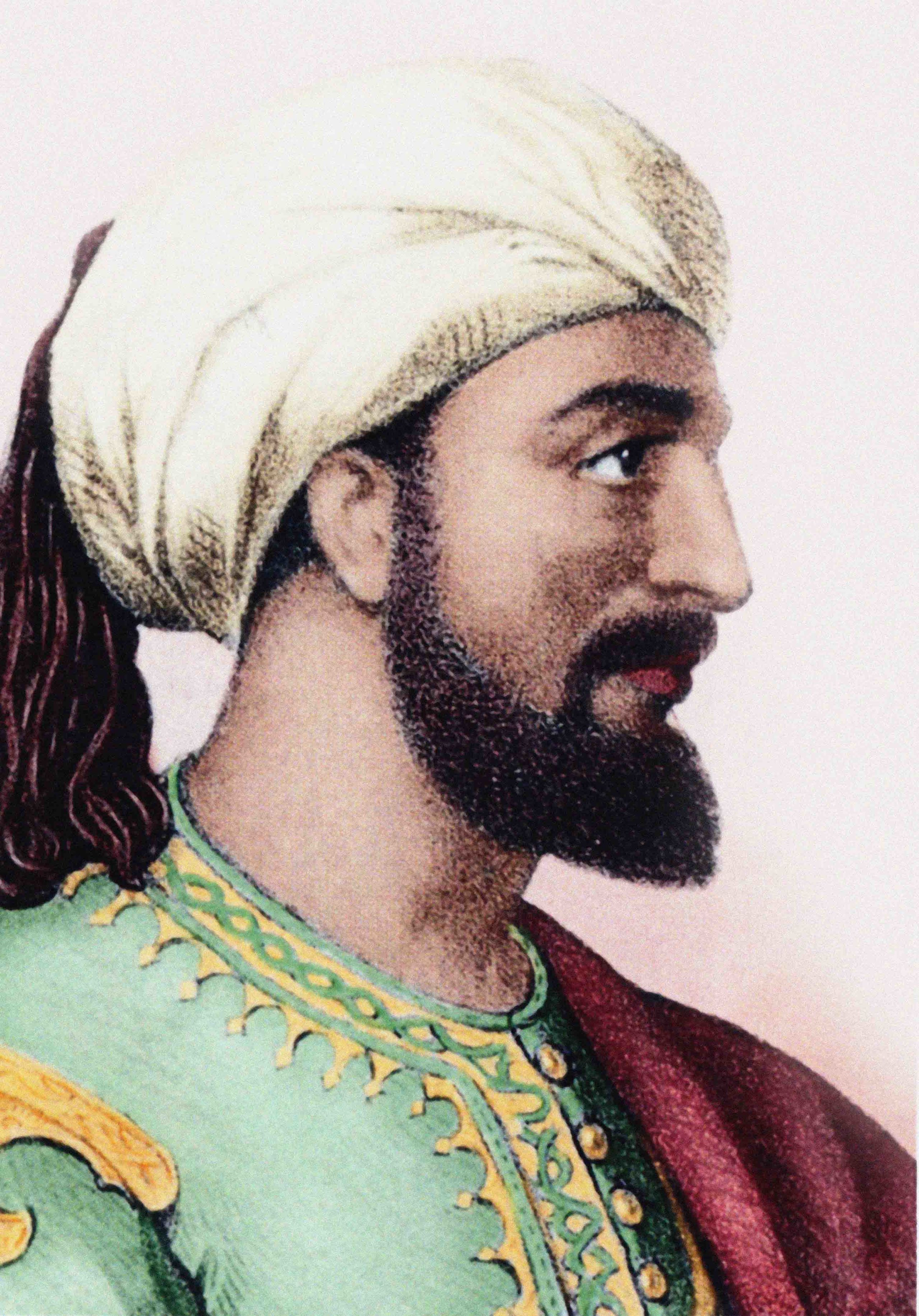
A 19th-century portrait of Abd Al-Rahman III, who in 929 transformed the Emirate of Cordoba into a caliphate. (Getty Images)
A 19th-century portrait of Abd Al-Rahman III, who in 929 transformed the Emirate of Cordoba into a caliphate. (Getty Images)
The swift victory, according to the Spanish historian Eduardo Manzano, was a product of “a very efficient military strategy” honed during the expansion of the caliphates in the Middle East and North Africa. “After defeating their enemies in one pitched battle — in Spain this was Guadalete — they headed towards the main cities and secured the principal routes of communication.”
The Arabs were also highly pragmatic and ready to reach agreements with local aristocracies: “Although the Arabs were conquerors and initially displayed a very tight political and social dominion, they soon realized that collaboration of local populations was of paramount importance for the consolidation of their rule.”
Also important, he said, was “the cohesive force of the Islamic faith. It should be borne in mind that at this early stage Islam was not radically opposed to Judaism and Christianity, as it claimed a sort of renewal and clarification of the message that had been transmitted by previous prophets but had been distorted by mankind.”
The following year, 712, Tariq was reinforced by a large Arab army led by Musa ibn Nusayr himself. The combined Berber-Arab force swept quickly through Iberia, capturing in quick succession Seville, Cordoba and Toledo, the Visigothic capital at the heart of the peninsula. By 717, the invaders had occupied almost the whole of the peninsula and had even crossed the Pyrenees into the lands of the Franks — modern-day France.
In 715, Abd Al-Aziz, the son of Musa ibn Nusayr, was installed as the first governor of the territory known to the Muslims as Al-Andalus. Virtually the whole of what is modern-day Spain was now a province of the Umayyad caliphate.

Abd Al-Aziz, the son of Musa ibn Nusayr, was installed as the first governor of Al-Andalus in 715. (Getty Images)
Academics continue to debate the origin of the name “Al-Andalus.” Some say it derives from the word “Vandals,” the Germanic people who had preceded the Visigoths in Iberia in the fifth century. It may, say others, be a corruption of “Atlantis,” or perhaps it comes from the Gothic word “landahlaut,” referring to the parcels of land given to Visigothic nobles.
Either way, Al-Andalus first appears in the written record on coins minted in the newly acquired Umayyad province within a few years of the rapid conquest of Iberia. One, in the collection of the British Museum in London, bears the inscription: “In the name of God, this dirham was minted in Al-Andalus in the year 168” – about 784 in the Gregorian calendar.

The name “Al-Andalus” first appears in writing on coins, such as this one, which includes the inscription: "In the name of God, this dirham was minted in Al-Andalus in the year 168" – about 784 in the Gregorian calendar. (British Museum)
Over the next 15 years, the Muslims seized a large part of southern France and pushed deep into Frankish territory. The expansion northwards was finally halted only in 732, when the Muslims were defeated at the Battle of Tours by Charles Martel, the ruler of Francia.
They had arrived within 200 kilometers of Paris. In later Christian accounts, Martel was credited with having saved the whole of Europe from Muslim occupation. For the 18th-century British historian Edward Gibbon, the battle was nothing less than “an encounter which would change the history of the world.” But in reality, the northern incursion may have been nothing more than a raid in strength, a hunt for loot that simply overreached itself.
“Why the Muslims stopped after they were defeated by Martel is an interesting question,” said Drayson. “One theory is that because the majority of the army were Berbers, they came from very poor, barren regions in North Africa and were very happy just to settle in the fertile lands of Spain, particularly in the south.
“They were more motivated by settling somewhere productive than possibly getting more booty.”
Retiring back over the Pyrenees, the Muslims remained in control of Iberia — for the time being, at least. But violent events over 4,500 kilometers away were about to shape the new territory’s destiny for centuries to come.
The conquest of Iberia had taken place under the auspices of the Umayyad caliphate, the second of the caliphates to be founded after the death of the Prophet Muhammad. By 750, the caliphate, based in Damascus, had established one of the largest empires the world had ever seen, stretching from Persia in the east to North Africa and Iberia in the west. But it came crashing down in 750 when the Abbasid dynasty in Baghdad rose in rebellion and nearly every member of the Umayyad dynasty was massacred.
“Only one survived,” said Drayson. “Abd Al-Rahman I. He fled to Spain and set up the Umayyad Emirate in Cordoba, which would eventually become a caliphate, and this was the start of the wonderful golden age of Muslim culture in Spain.”

A lithograph depicting Abd Al-Rahman I, who founded the Umayyad Emirate of Cordoba in 756. (Getty Images)
One of the greatest symbols of that culture was the Great Mosque of Cordoba, one of the first projects ordered by Abd Al-Rahman after he declared himself emir of Cordoba in 756. Work on the mosque, and consolidation of the territory of the emirate, was continued by his descendants until in 929 Abd Al-Rahman III transformed the emirate into the Caliphate of Cordoba, in defiance of the Abbasid and Fatimid caliphates entrenched in North Africa, Arabia and Persia.

A 19th-century portrait of Abd Al-Rahman III, who in 929 transformed the Emirate of Cordoba into a caliphate. (Getty Images)
“In the old capital of Al-Andalus, Cordoba, we have the two greatest examples from this period of splendor: Madinat Al-Zahra and the Great Mosque,” said author and Andalusian sources researcher Daniel Valdivieso Ramos, also a collaborator with the Archaeological Ensemble of Madinat Al-Zahra and Casa Arabe in Cordoba.
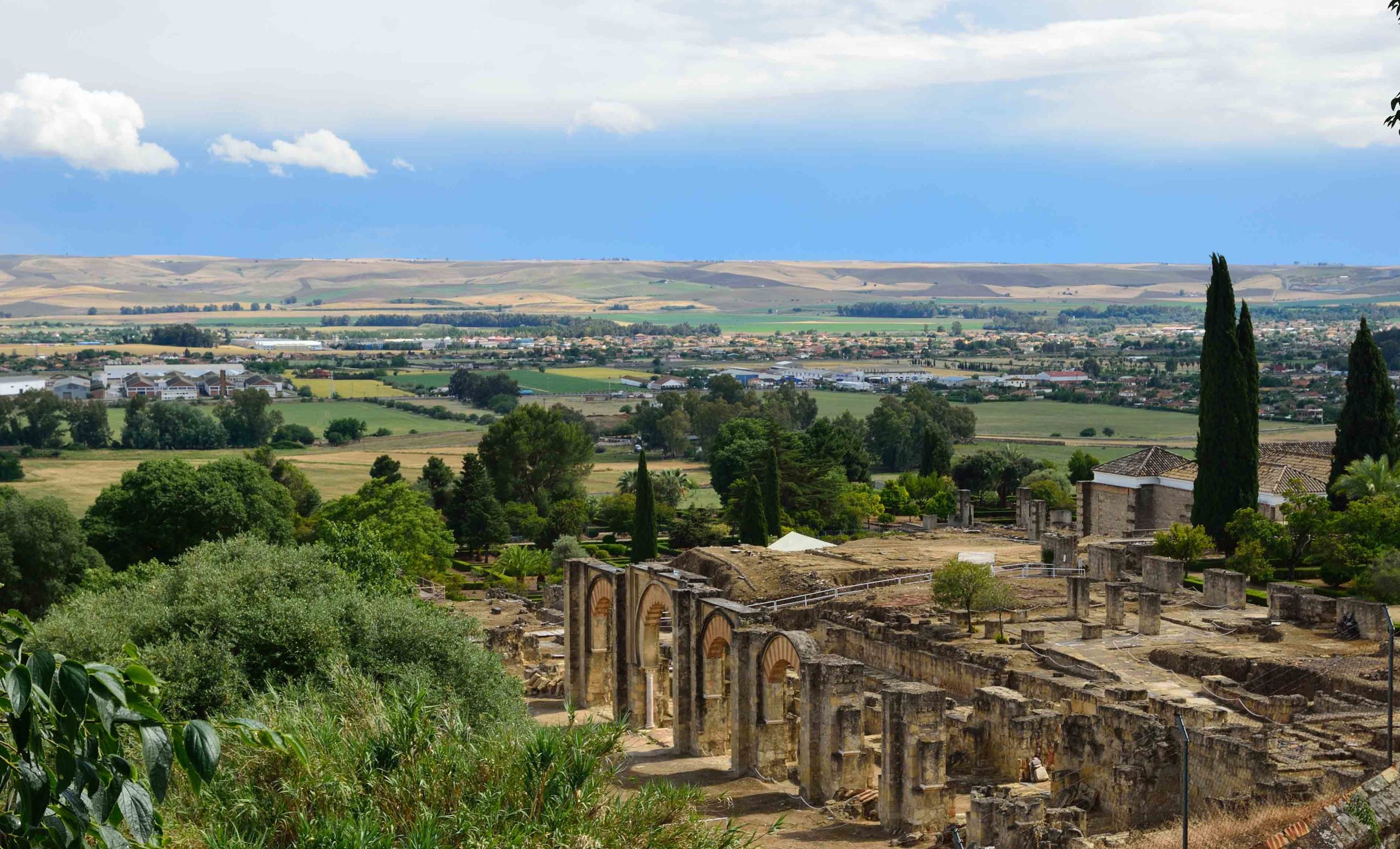
Ruins of the vast palace city Madinat Al-Zahra, near Cordoba. (Shutterstock)
“Even the town’s historic quarter preserves the appearance of the classic madinat. One only need remember the famous poem by Nizar Qabbani in which he beautifully compared the Andalusian city with his hometown, Damascus.”
Daniel Valdivieso Ramos recites the poem by Nizar Qabbani for us in the streets of Cordoba.
Today a spectacular ruin, the Madinat Al-Zahra, a vast fortified palace and the seat of the caliphate’s government built by Abd Al-Rahman III, was in 2018 declared a UNESCO World Heritage Site. “This complete urban ensemble,” read the Spanish government’s nomination report, “features infrastructure such as roads, bridges, water systems, buildings, decorative elements and everyday objects (and) provides in-depth knowledge of the now vanished Western Islamic civilization of Al-Andalus, at the height of its splendor.”
Indeed, at the height of the caliphate’s power in the 10th century, the city of Cordoba “rivalled Baghdad and Damascus in its opulence and splendor,” wrote British author Matthew Carr in “Blood and Faith,” his history of the purging of Muslim Spain in the 15th and 16th centuries.
Cordoba was “a metropolis without parallel in the Christian world, boasting paved roads and streetlights, hospitals, schools, public baths, and libraries.”
Experts on Al-Andalus take us inside Granada’s Alhambra and through the streets of Cordoba to show us the Islamic architectural influence of that period.
Carr describes “a cottage industry of Arabic calligraphers” producing 60,000 books every year, while the libraries of Al-Hakam II, the son of Abd Al-Rahman III and Cordoba’s second caliph, “were said to contain some 400,000 manuscripts on a variety of subjects from poetry and theology to philosophy, medicine, and agriculture.”
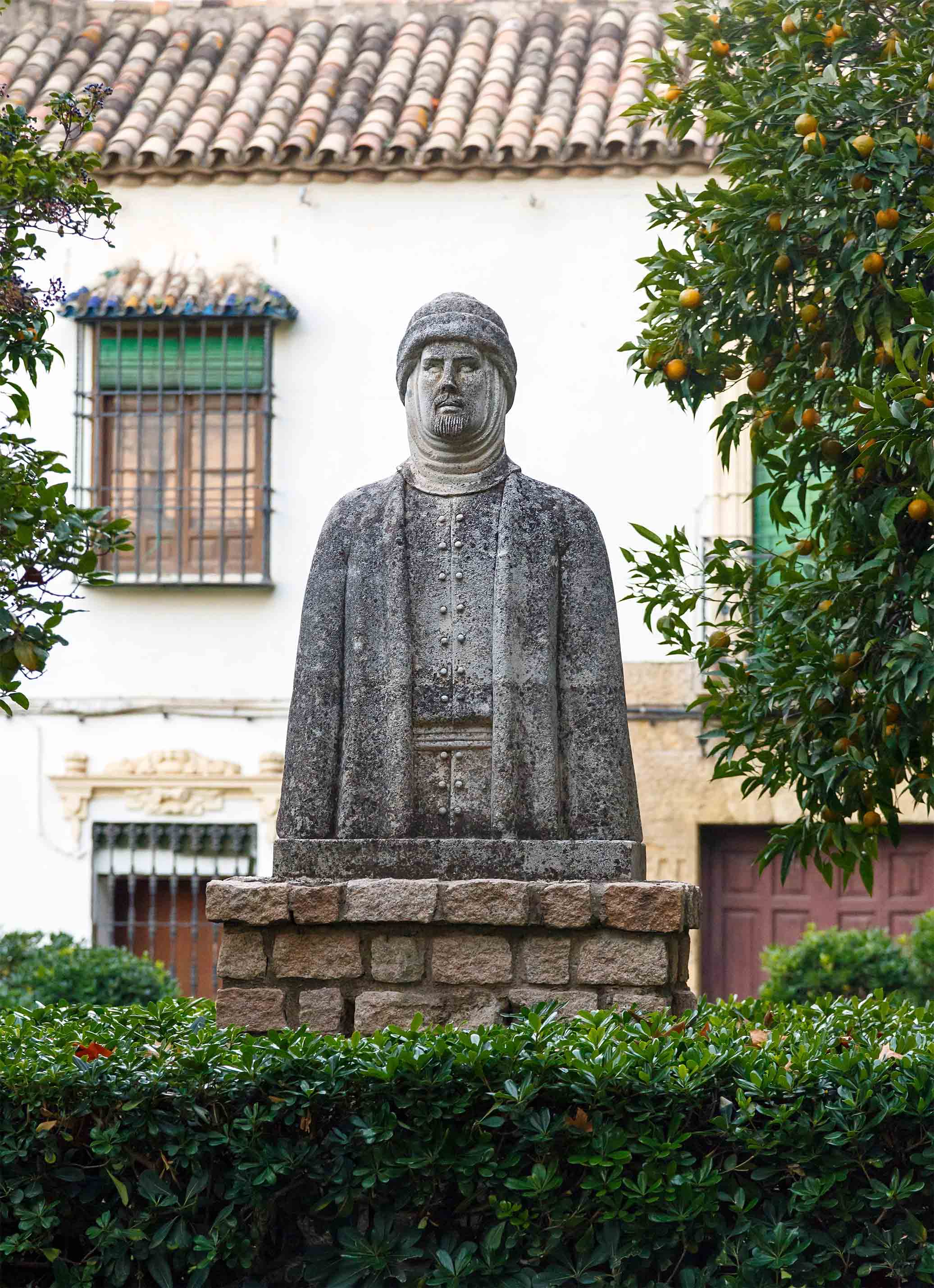
A statue in Cordoba pays tribute to its second caliph Al-Hakam II, the son of Abd Al-Rahman III. He ruled from 961 to 976 and was renowned for his libraries.
Today, wrote the historian Richard Bulliet in his 2004 book “The Case for Islamo-Christian Civilization,” “few people in the West appreciate the massive transfer of culture, science, and technology that began during this period,” a transfer that “paved the way for Europe’s later scientific discoveries and intellectual sophistication.”
Bulliet records “a cornucopia of stimuli from Muslim lands” that transformed many aspects of European life, including “philosophy (commentaries on Aristotle), theology (Averroism), mathematics (Arabic numerals), chemistry (gunpowder), medicine (surgical technique), music (lute-playing, troubadour songs), literature (tales that show up in Italian works), manufacturing (glass, paper, woodblock printing), cuisine (pasta, sugar)” and “the enjoyment of everyday life.”
But the caliphate would survive for little more than 100 years. “The Cordoba Umayyad dynasty was not exempt, like any other, from internal crises that ended up undermining its stability,” said Barbara Boloix Gallardo, historian and professor of Arabic and Islamic studies at the University of Granada.
“As a result, the territory of Al-Andalus was fragmented into different kingdoms, some peninsular Christian kingdoms were reinforced, and the ideology of ‘reconquest’ was forged.”
The Caliphate of Cordoba collapsed in 1031 after a 22-year civil war that saw its territory fragment into more than 30 independent Muslim principalities, or taifas, arguing among themselves even as the Christian kingdoms in the north embarked on the reconquista, their determined campaign to reclaim the peninsula.
It was the beginning of the end of Muslim rule in Iberia, but it was an end that would not come quickly. It would play out over four centuries as Christian forces expanded from the north, taking advantage of the bitter rivalries in Al-Andalus and North Africa that progressively weakened Muslim authority.
And, rather like the arc of a great firework, exploding in brilliant colors even as it falls toward the Earth, the period of the long, slow decline of Muslim rule in Iberia would nevertheless see the creation of some of the greatest treasures of Al-Andalus, which today define much of Spain’s cultural landscape.
“Everything indicates that the impact that Islamic culture had in Al-Andalus during the Middle Ages was huge,” said Manzano. “From the 8th century onwards, Al-Andalus increasingly became an Arab and Islamic society, which produced a rich cultural tradition and left a huge historical heritage.
“No matter how familiar one is with Al-Andalus, one is always surprised by the sophistication and complexity of its political organization, its social structure or its cultural production.”
It is, he said, “possible to identify many vestiges of the historical legacy of Al-Andalus not only in the spectacular monuments that have endured to this day, but also in humble archaeological remains, countless manuscripts or in the transmission of scientific ideas, some of which made an important contribution to human knowledge.”

Ruins of the vast palace city Madinat Al-Zahra, near Cordoba. (Shutterstock)
Ruins of the vast palace city Madinat Al-Zahra, near Cordoba. (Shutterstock)
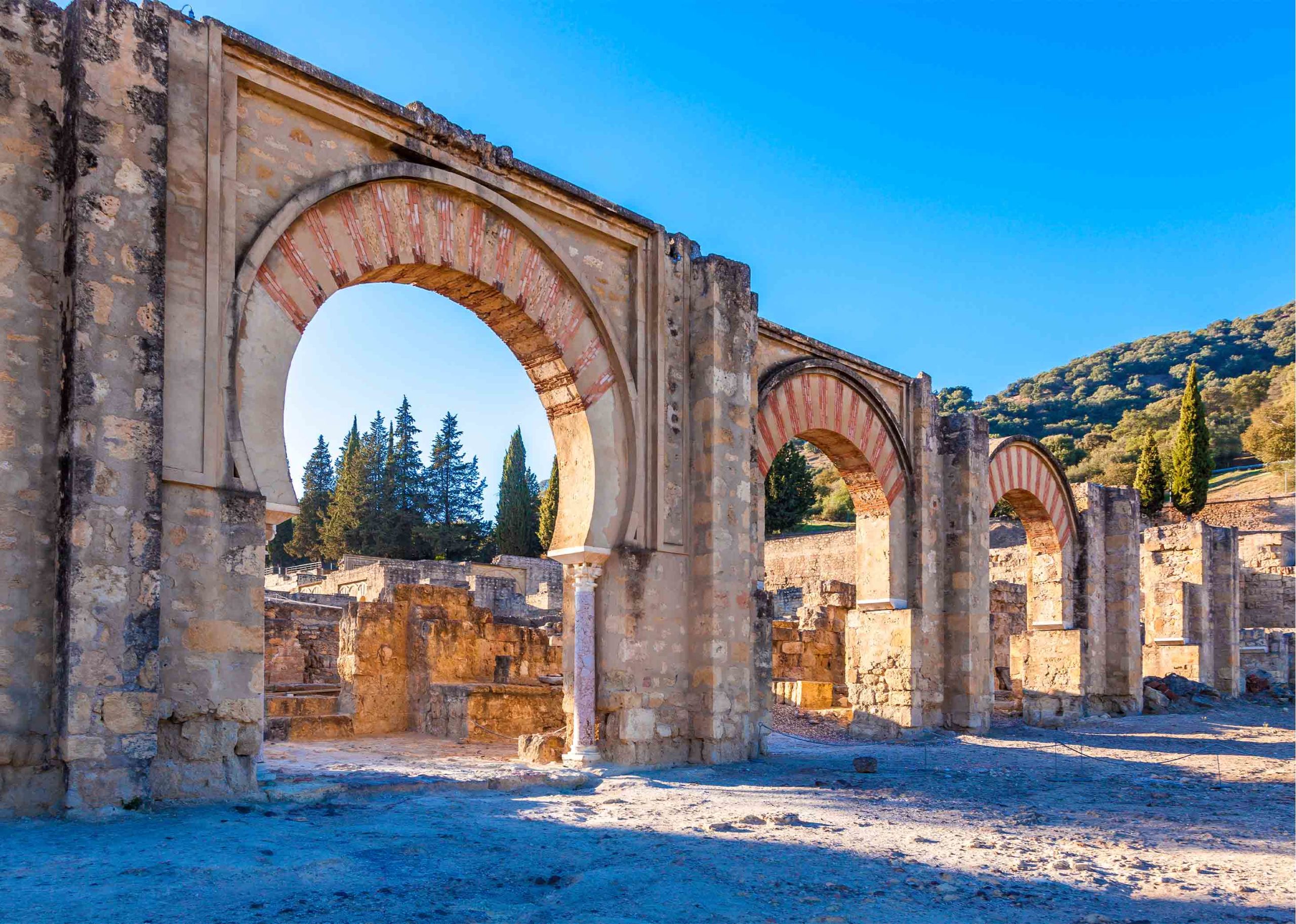
Madinat Al-Zahra was declared a UNESCO World Heritage Site in 2018. (Shutterstock)
Madinat Al-Zahra was declared a UNESCO World Heritage Site in 2018. (Shutterstock)
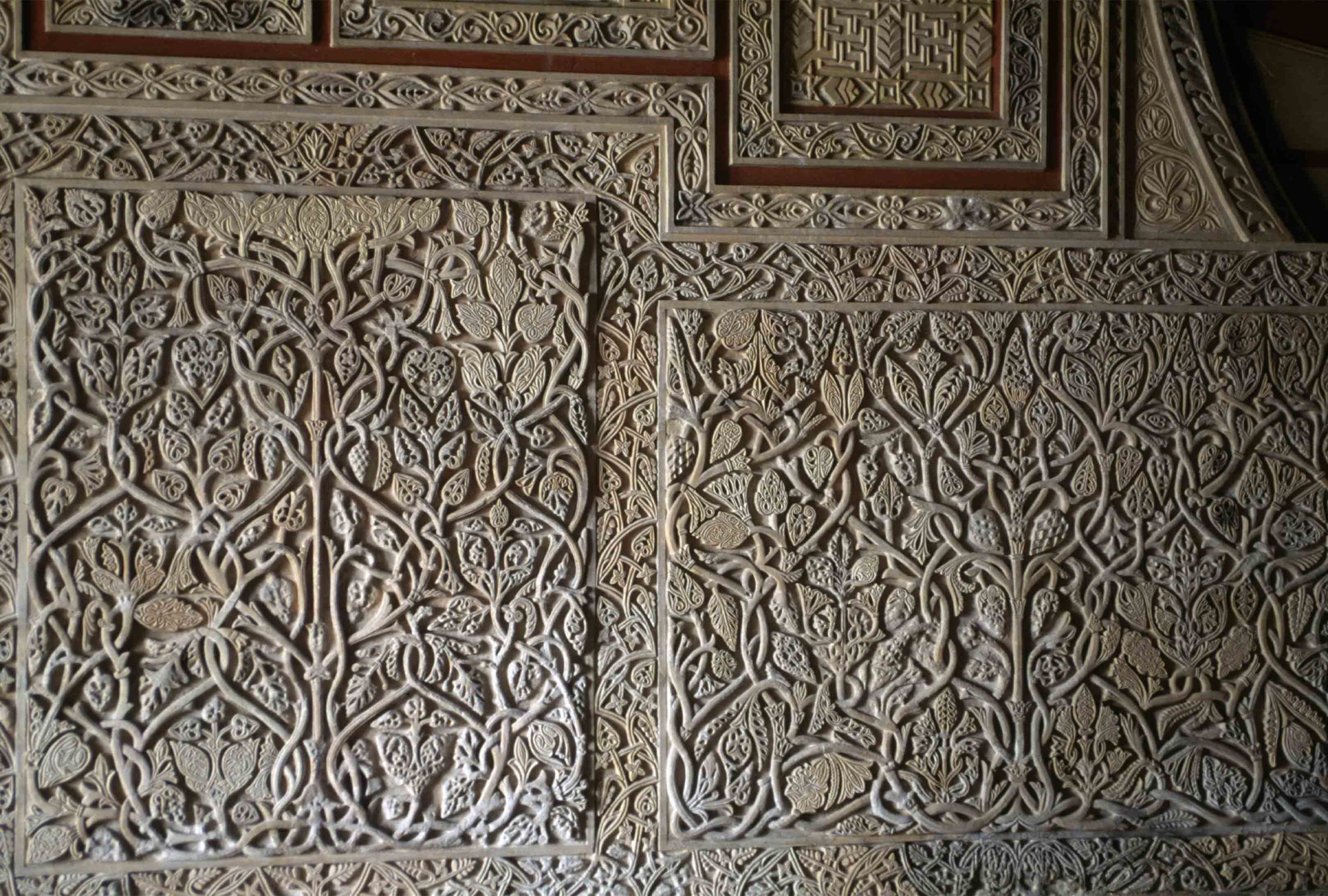
A 10th-century wall bas-relief in Madinat Al-Zahra's Salon Rico. (Getty Images)
A 10th-century wall bas-relief in Madinat Al-Zahra's Salon Rico. (Getty Images)

A statue in Cordoba pays tribute to its second caliph Al-Hakam II, the son of Abd Al-Rahman III. He ruled from 961 to 976 and was renowned for his libraries.
A statue in Cordoba pays tribute to its second caliph Al-Hakam II, the son of Abd Al-Rahman III. He ruled from 961 to 976 and was renowned for his libraries.
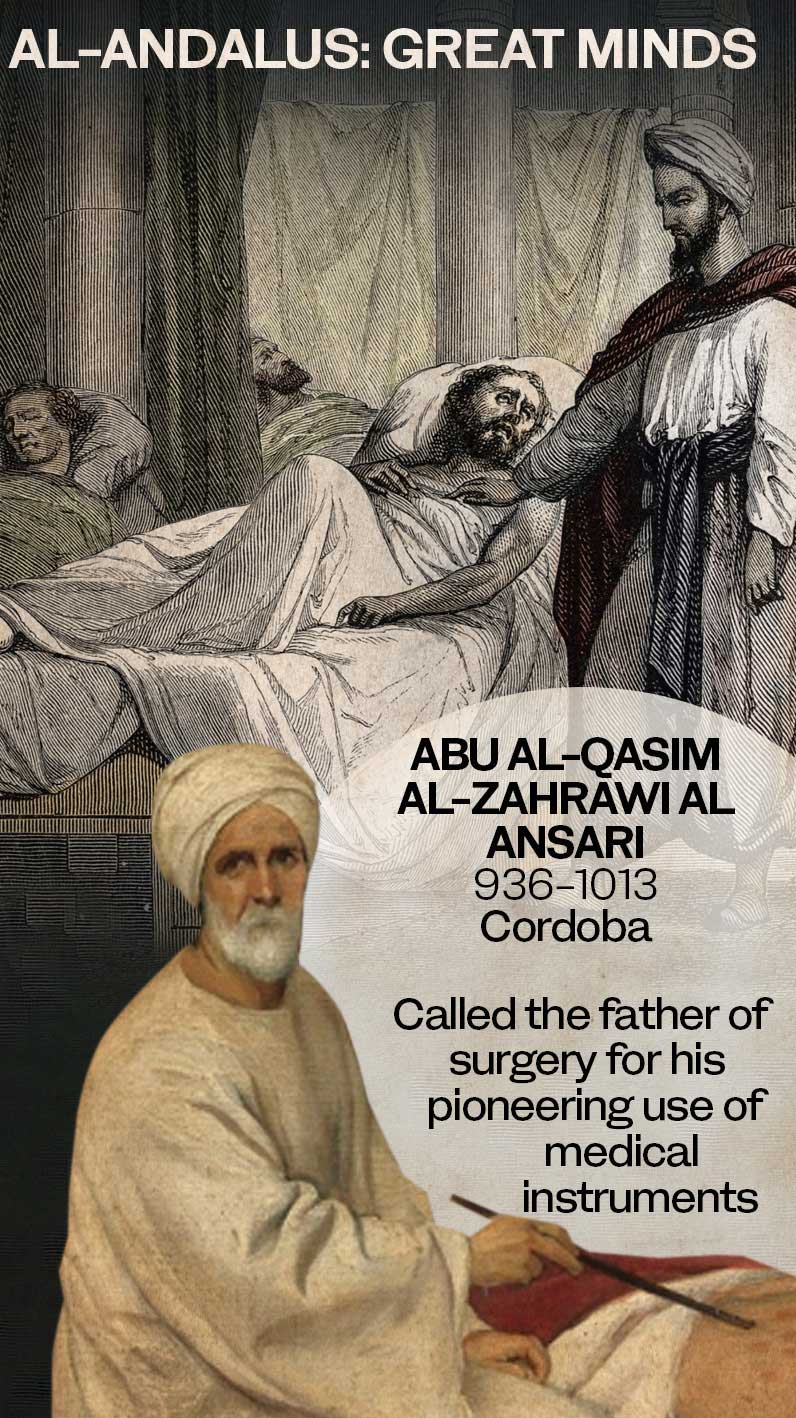
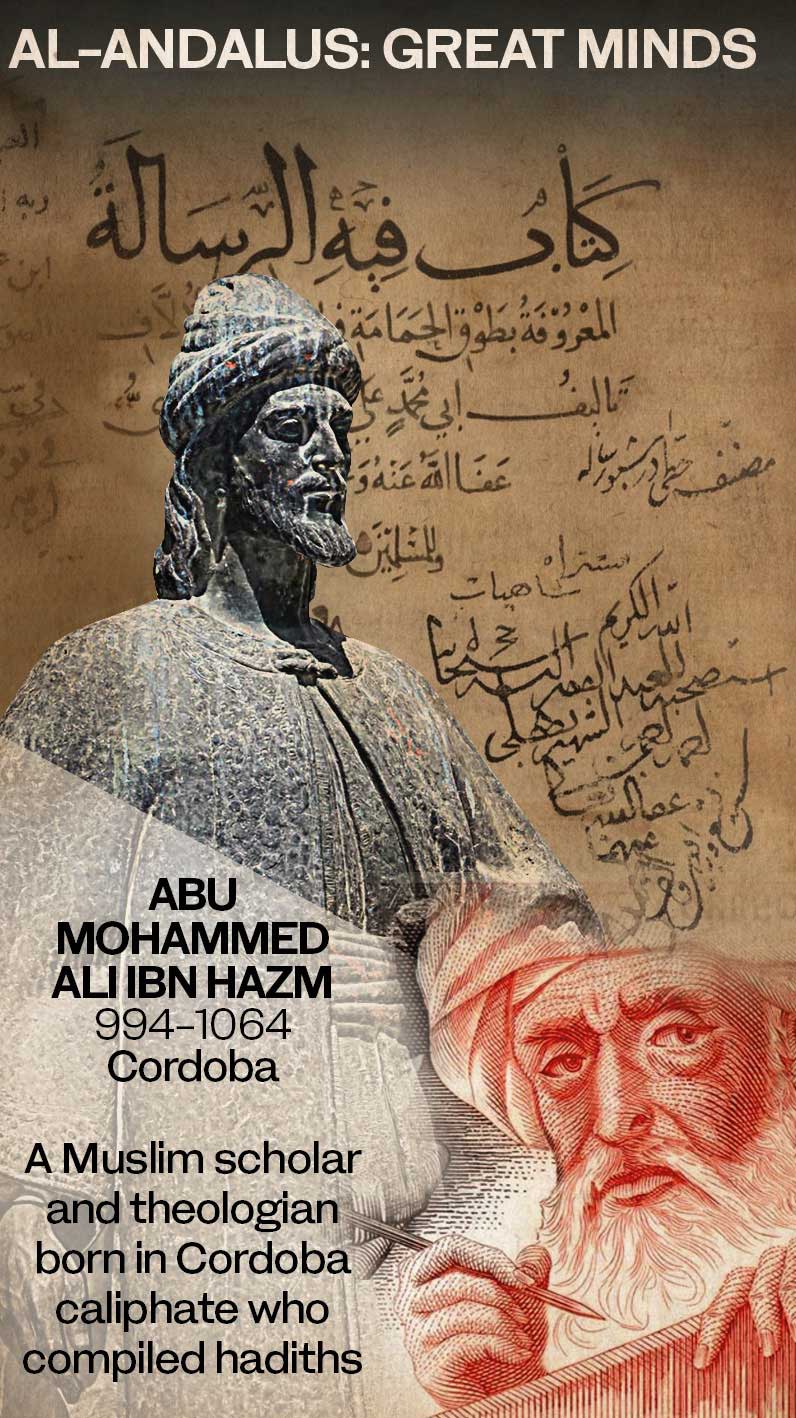
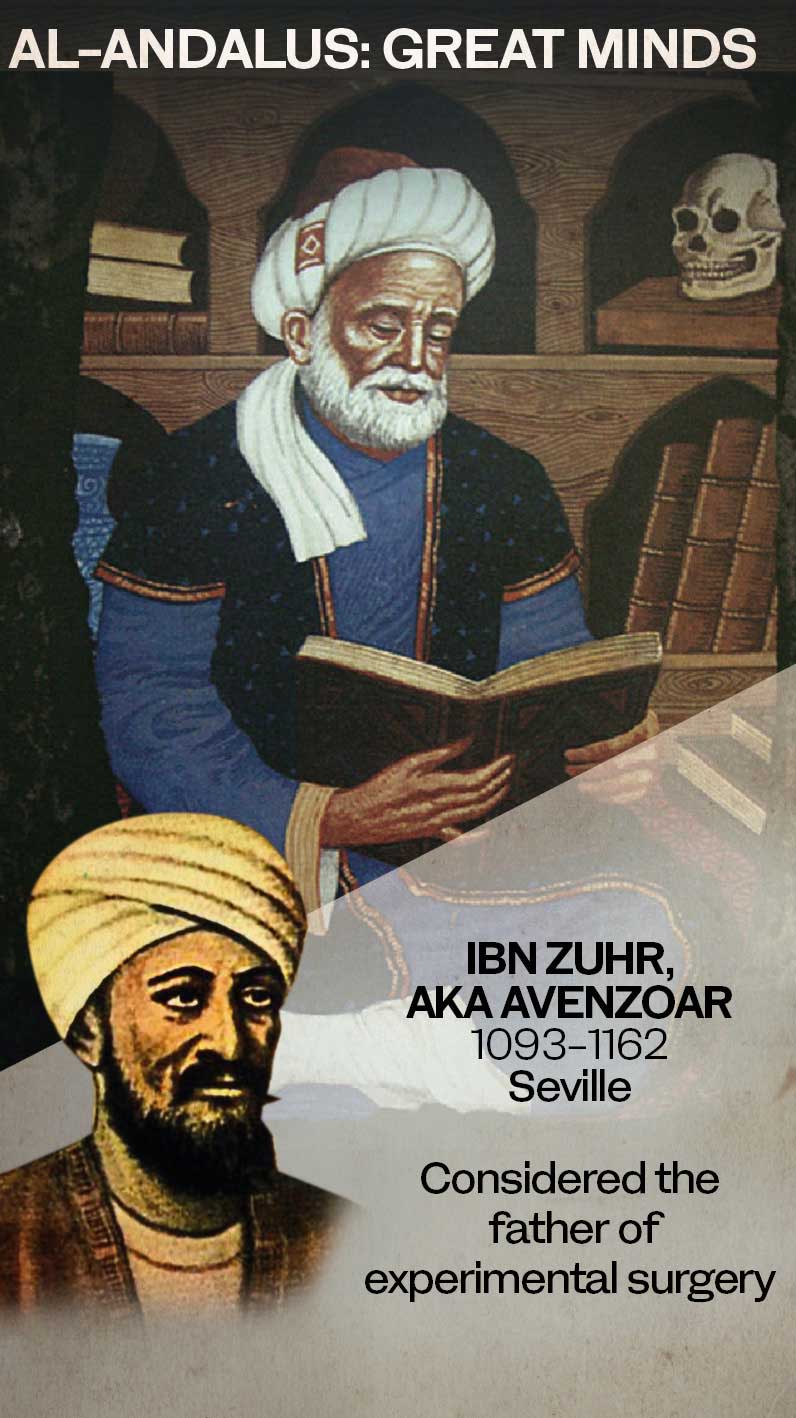
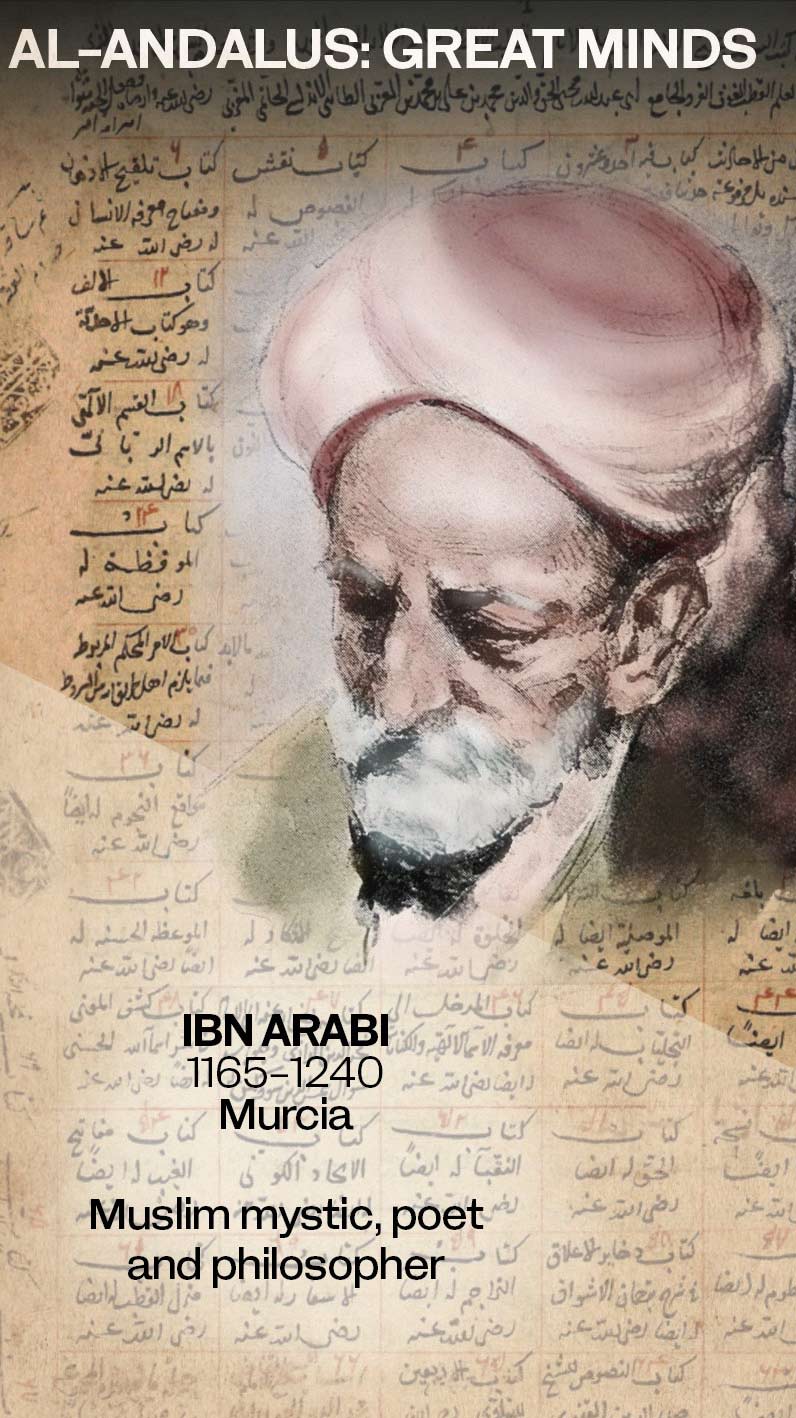
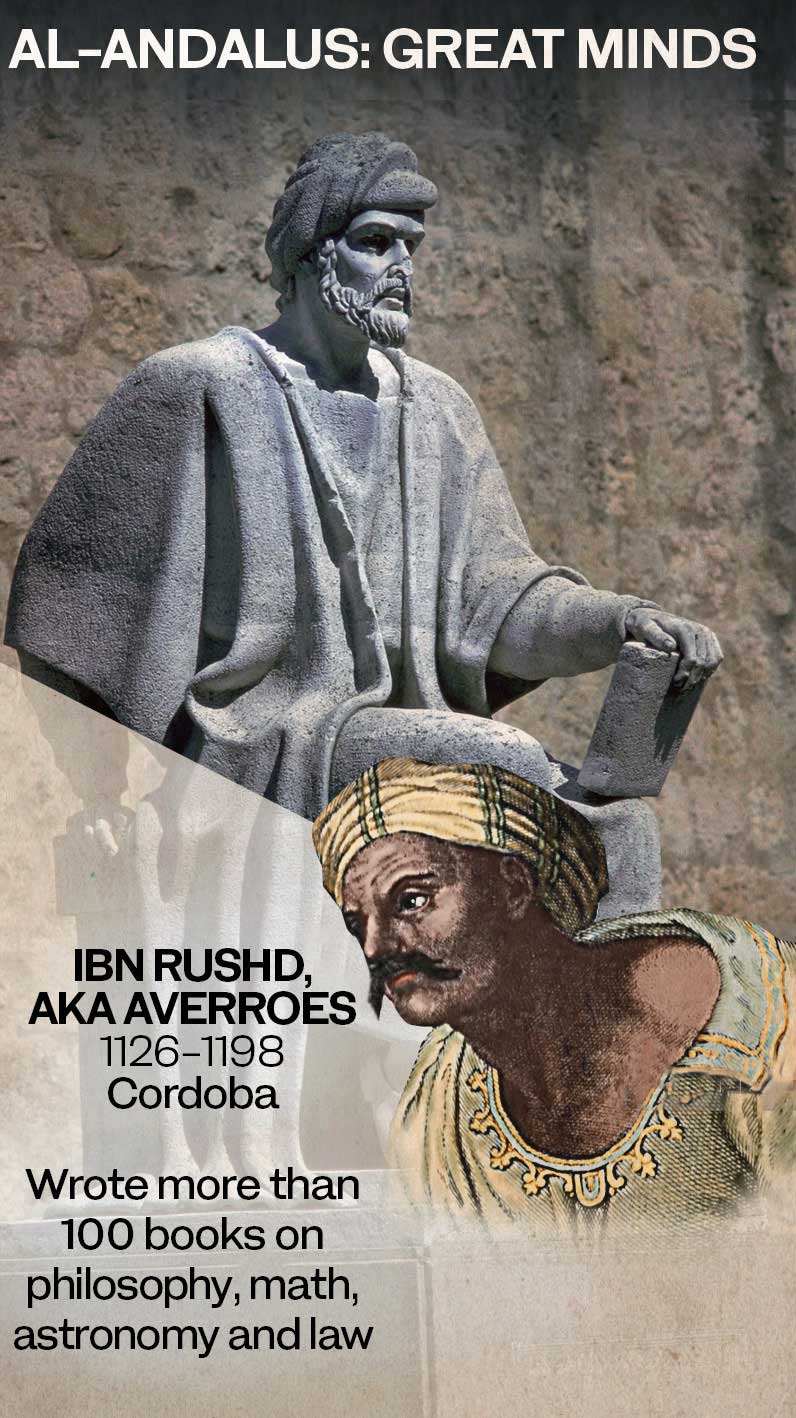
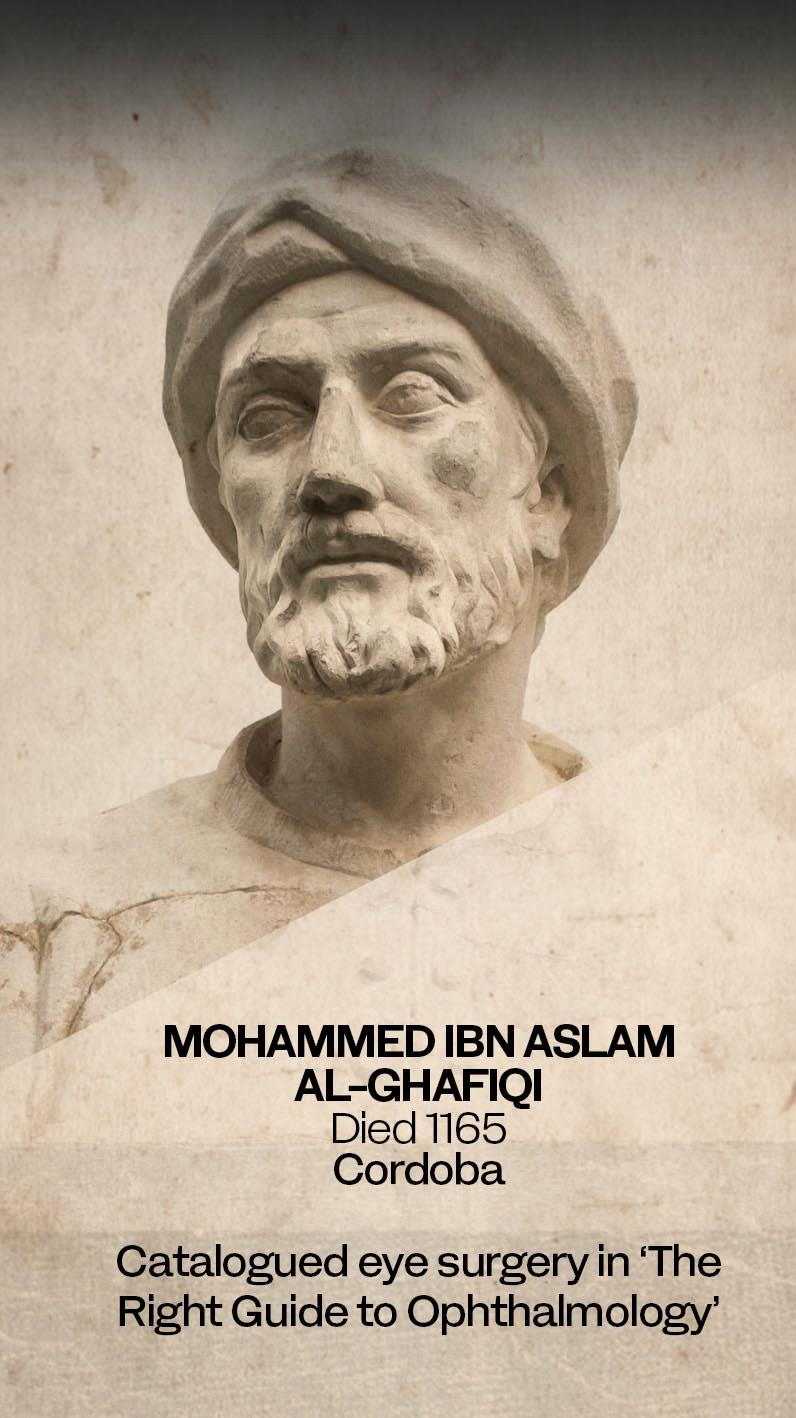
“In the old capital of Al-Andalus, Cordoba, we have the two greatest examples from this period of splendor: Madinat Al-Zahra and the Great Mosque,” said author and Andalusian sources researcher Daniel Valdivieso Ramos, also a collaborator with the Archaeological Ensemble of Madinat Al-Zahra and Casa Arabe in Cordoba.

Ruins of the vast palace city Madinat Al-Zahra, near Cordoba. (Shutterstock)
“Even the town’s historic quarter preserves the appearance of the classic madinat. One only need remember the famous poem by Nizar Qabbani in which he beautifully compared the Andalusian city with his hometown, Damascus.”
Daniel Valdivieso Ramos recites the poem by Nizar Qabbani for us in the streets of Cordoba.
Today a spectacular ruin, the Madinat Al-Zahra, a vast fortified palace and the seat of the caliphate’s government built by Abd Al-Rahman III, was in 2018 declared a UNESCO World Heritage Site. “This complete urban ensemble,” read the Spanish government’s nomination report, “features infrastructure such as roads, bridges, water systems, buildings, decorative elements and everyday objects (and) provides in-depth knowledge of the now vanished Western Islamic civilization of Al-Andalus, at the height of its splendor.”
Indeed, at the height of the caliphate’s power in the 10th century, the city of Cordoba “rivalled Baghdad and Damascus in its opulence and splendor,” wrote British author Matthew Carr in “Blood and Faith,” his history of the purging of Muslim Spain in the 15th and 16th centuries.
Cordoba was “a metropolis without parallel in the Christian world, boasting paved roads and streetlights, hospitals, schools, public baths, and libraries.”
Experts on Al-Andalus take us inside Granada’s Alhambra and through the streets of Cordoba to show us the Islamic architectural influence of that period.
Carr describes “a cottage industry of Arabic calligraphers” producing 60,000 books every year, while the libraries of Al-Hakam II, the son of Abd Al-Rahman III and Cordoba’s second caliph, “were said to contain some 400,000 manuscripts on a variety of subjects from poetry and theology to philosophy, medicine, and agriculture.”

A statue in Cordoba pays tribute to its second caliph Al-Hakam II, the son of Abd Al-Rahman III. He ruled from 961 to 976 and was renowned for his libraries.
Today, wrote the historian Richard Bulliet in his 2004 book “The Case for Islamo-Christian Civilization,” “few people in the West appreciate the massive transfer of culture, science, and technology that began during this period,” a transfer that “paved the way for Europe’s later scientific discoveries and intellectual sophistication.”
Bulliet records “a cornucopia of stimuli from Muslim lands” that transformed many aspects of European life, including “philosophy (commentaries on Aristotle), theology (Averroism), mathematics (Arabic numerals), chemistry (gunpowder), medicine (surgical technique), music (lute-playing, troubadour songs), literature (tales that show up in Italian works), manufacturing (glass, paper, woodblock printing), cuisine (pasta, sugar)” and “the enjoyment of everyday life.”

But the caliphate would survive for little more than 100 years. “The Cordoba Umayyad dynasty was not exempt, like any other, from internal crises that ended up undermining its stability,” said Barbara Boloix Gallardo, historian and professor of Arabic and Islamic studies at the University of Granada.
“As a result, the territory of Al-Andalus was fragmented into different kingdoms, some peninsular Christian kingdoms were reinforced, and the ideology of ‘reconquest’ was forged.”
The Caliphate of Cordoba collapsed in 1031 after a 22-year civil war that saw its territory fragment into more than 30 independent Muslim principalities, or taifas, arguing among themselves even as the Christian kingdoms in the north embarked on the reconquista, their determined campaign to reclaim the peninsula.
It was the beginning of the end of Muslim rule in Iberia, but it was an end that would not come quickly. It would play out over four centuries as Christian forces expanded from the north, taking advantage of the bitter rivalries in Al-Andalus and North Africa that progressively weakened Muslim authority.
And, rather like the arc of a great firework, exploding in brilliant colors even as it falls toward the Earth, the period of the long, slow decline of Muslim rule in Iberia would nevertheless see the creation of some of the greatest treasures of Al-Andalus, which today define much of Spain’s cultural landscape.
“Everything indicates that the impact that Islamic culture had in Al-Andalus during the Middle Ages was huge,” said Manzano. “From the 8th century onwards, Al-Andalus increasingly became an Arab and Islamic society, which produced a rich cultural tradition and left a huge historical heritage.
“No matter how familiar one is with Al-Andalus, one is always surprised by the sophistication and complexity of its political organization, its social structure or its cultural production.”
It is, he said, “possible to identify many vestiges of the historical legacy of Al-Andalus not only in the spectacular monuments that have endured to this day, but also in humble archaeological remains, countless manuscripts or in the transmission of scientific ideas, some of which made an important contribution to human knowledge.”

Ruins of the vast palace city Madinat Al-Zahra, near Cordoba. (Shutterstock)
Ruins of the vast palace city Madinat Al-Zahra, near Cordoba. (Shutterstock)

Madinat Al-Zahra was declared a UNESCO World Heritage Site in 2018. (Shutterstock)
Madinat Al-Zahra was declared a UNESCO World Heritage Site in 2018. (Shutterstock)

A 10th-century wall bas-relief in Madinat Al-Zahra's Salon Rico. (Getty Images)
A 10th-century wall bas-relief in Madinat Al-Zahra's Salon Rico. (Getty Images)

A statue in Cordoba pays tribute to its second caliph Al-Hakam II, the son of Abd Al-Rahman III. He ruled from 961 to 976 and was renowned for his libraries.
A statue in Cordoba pays tribute to its second caliph Al-Hakam II, the son of Abd Al-Rahman III. He ruled from 961 to 976 and was renowned for his libraries.
The fall of Al-Andalus
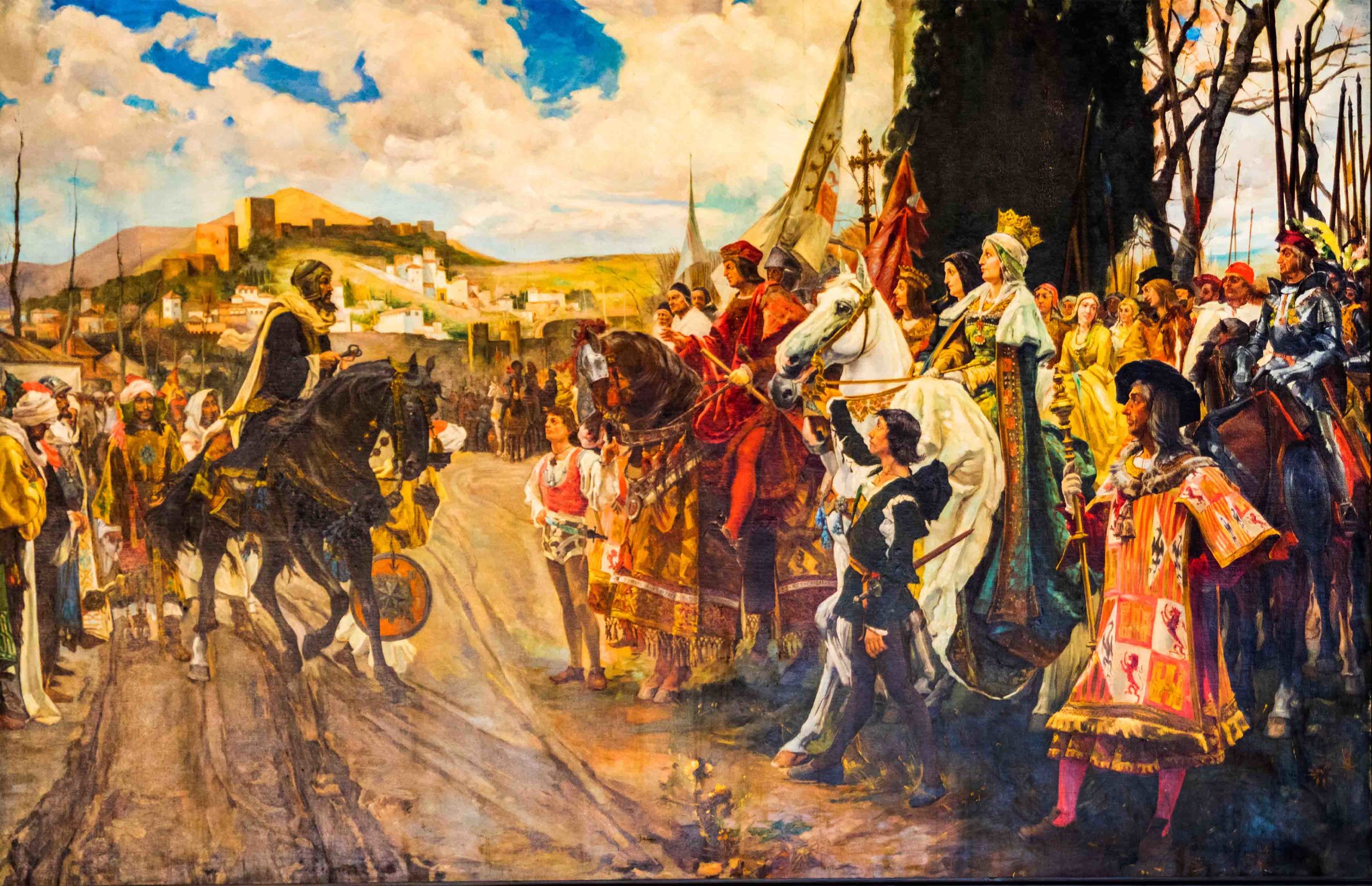
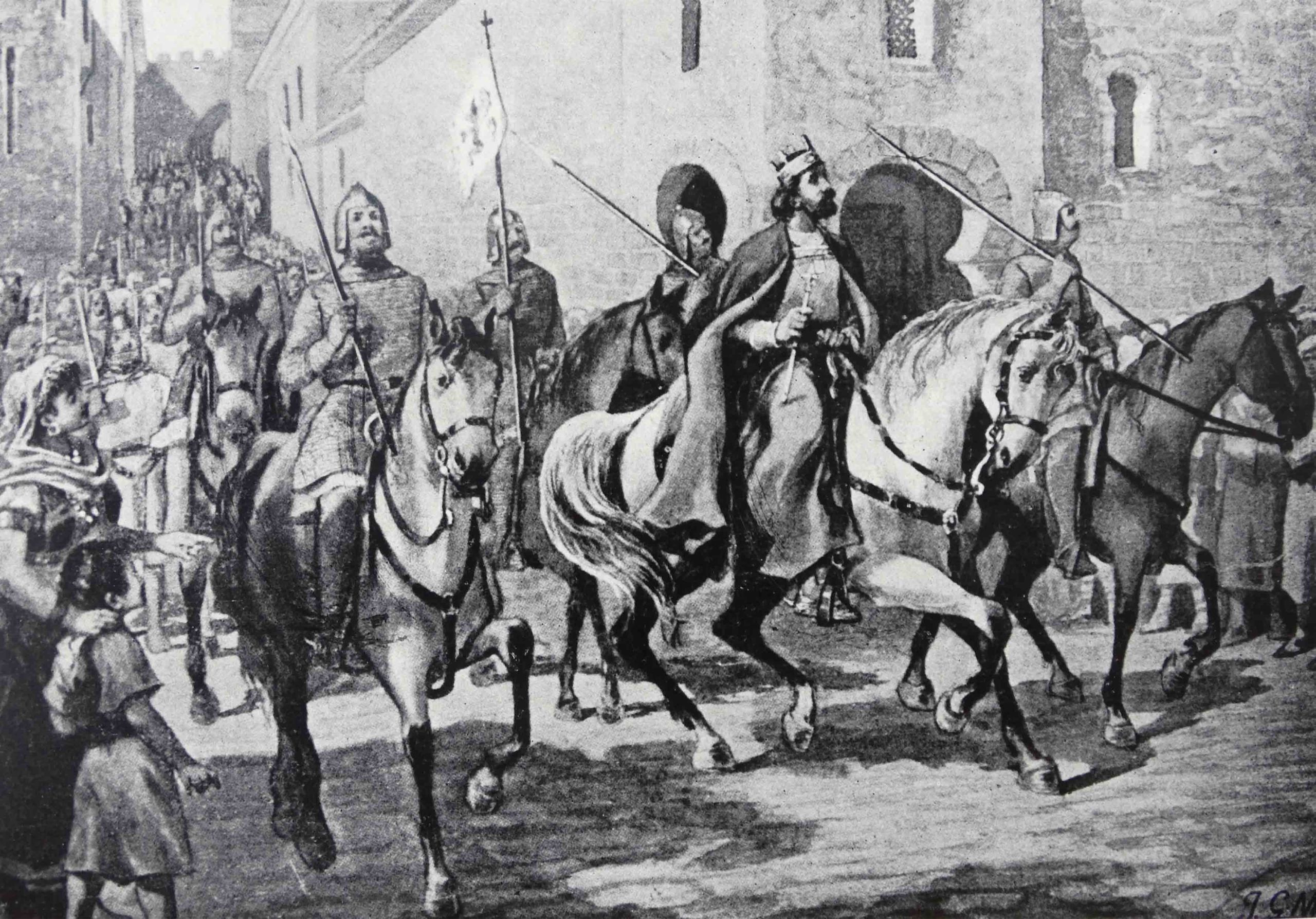
An undated illustration shows King Alfonso VI of Leon and Castile entering Toledo in 1085. (Getty Images)
An undated illustration shows King Alfonso VI of Leon and Castile entering Toledo in 1085. (Getty Images)
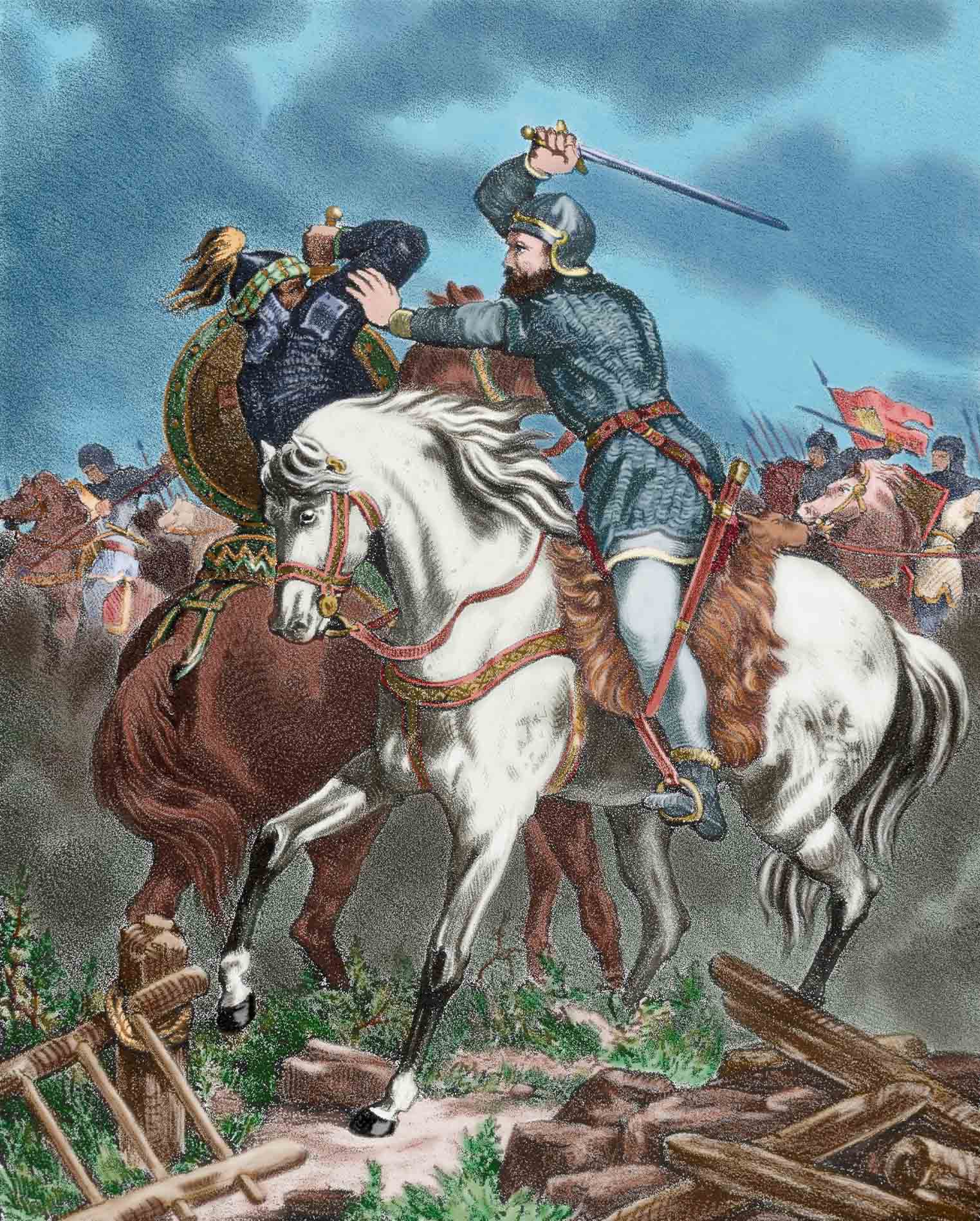
A 19th-century engraving of the Battle of Sagrajas (1086) between the Almoravid army led by Yusuf ibn Tashfin and the Christian army led by the Castilian King Alfonso VI. (Getty Images)
A 19th-century engraving of the Battle of Sagrajas (1086) between the Almoravid army led by Yusuf ibn Tashfin and the Christian army led by the Castilian King Alfonso VI. (Getty Images)
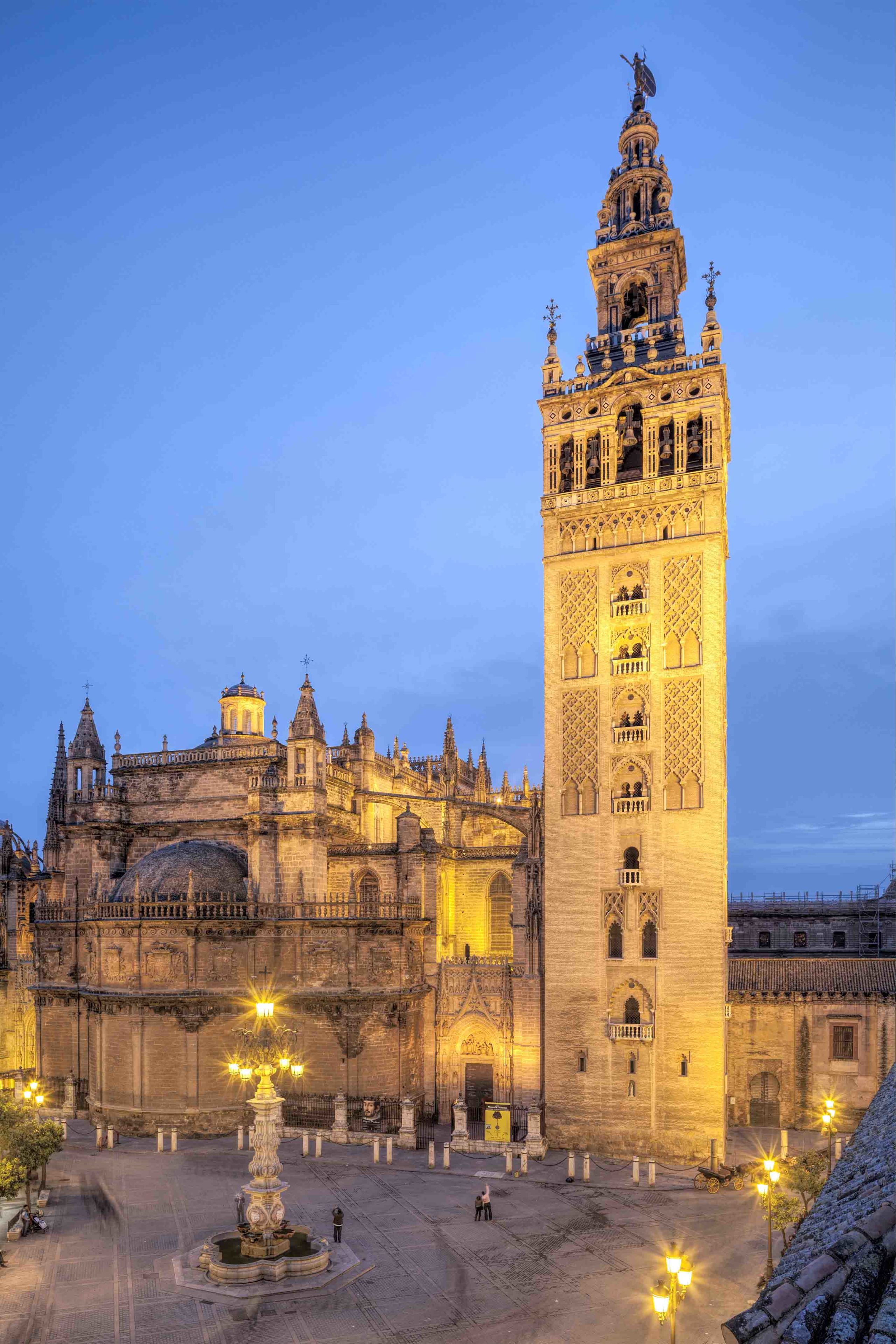
The Giralda Tower, once a minaret, is all that remains of Seville's mosque, which was replaced with a cathedral after the Christians took over in 1248. (Getty Images)
The Giralda Tower, once a minaret, is all that remains of Seville's mosque, which was replaced with a cathedral after the Christians took over in 1248. (Getty Images)
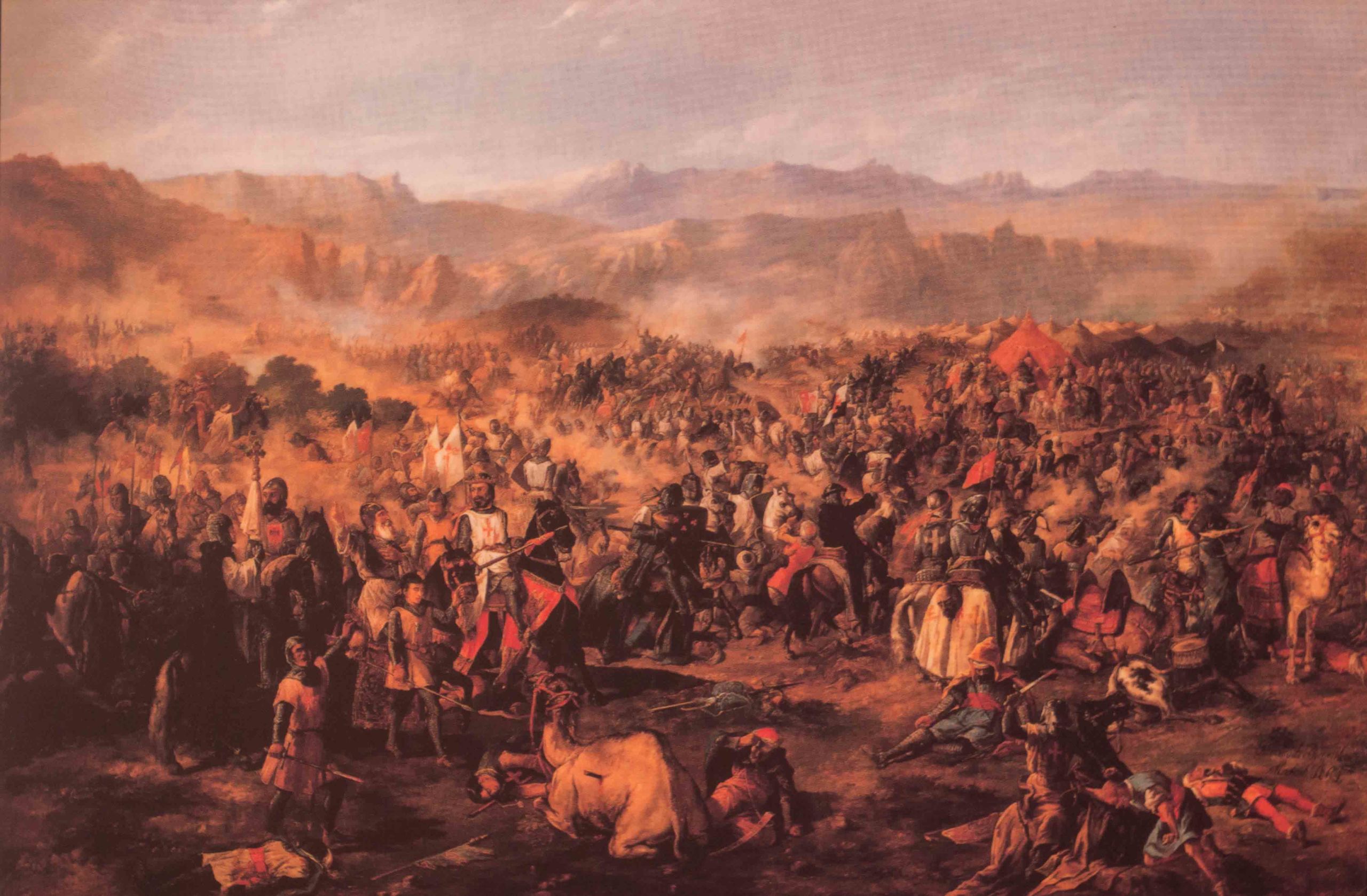
The Battle of Las Navas de Tolosa, the subject of this 19th-century painting, was seen as a turning point in the fortunes of the Almohads. (Alamy)
The Battle of Las Navas de Tolosa, the subject of this 19th-century painting, was seen as a turning point in the fortunes of the Almohads. (Alamy)
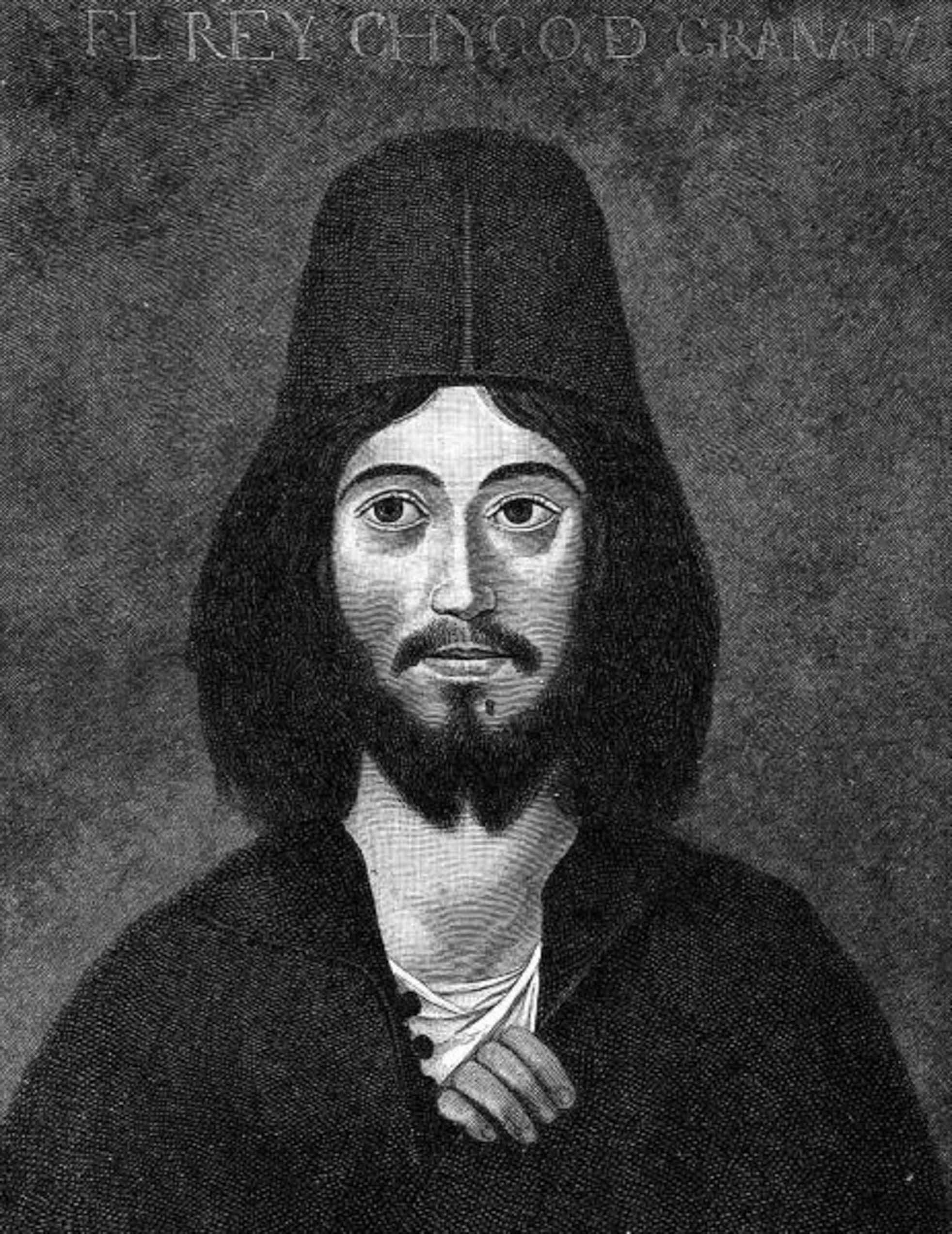
Mohammed XII, also known as Boabdil, the ultimate ruler of the Nasrid Emirate of Granada. (Alamy)
Mohammed XII, also known as Boabdil, the ultimate ruler of the Nasrid Emirate of Granada. (Alamy)
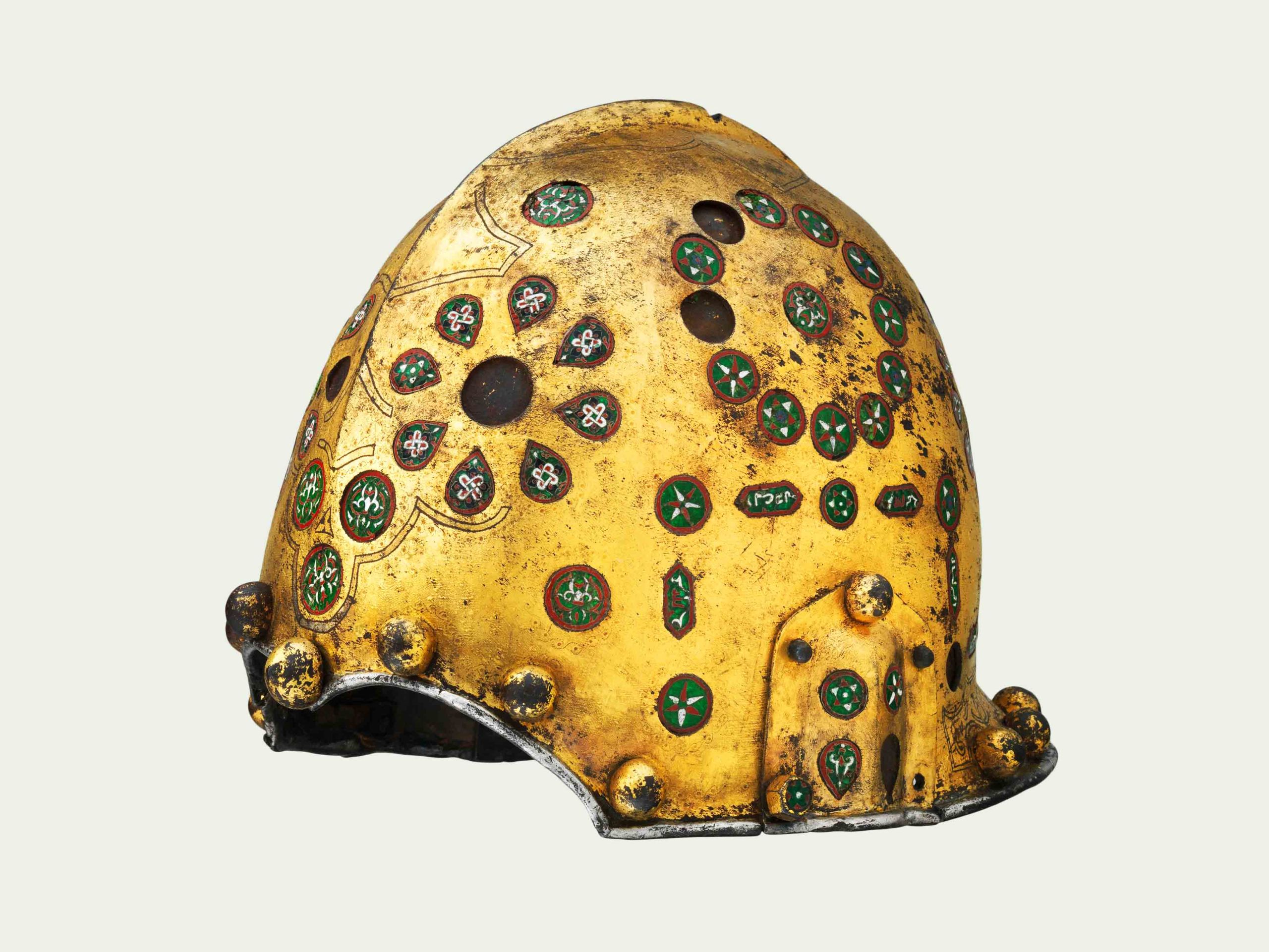
This helmet is said to have belonged to Boabdil, last Nasrid king of Granada. It is the only known example of armor to survive from the Nasrid period in Spain. (Getty Images)
This helmet is said to have belonged to Boabdil, last Nasrid king of Granada. It is the only known example of armor to survive from the Nasrid period in Spain. (Getty Images)
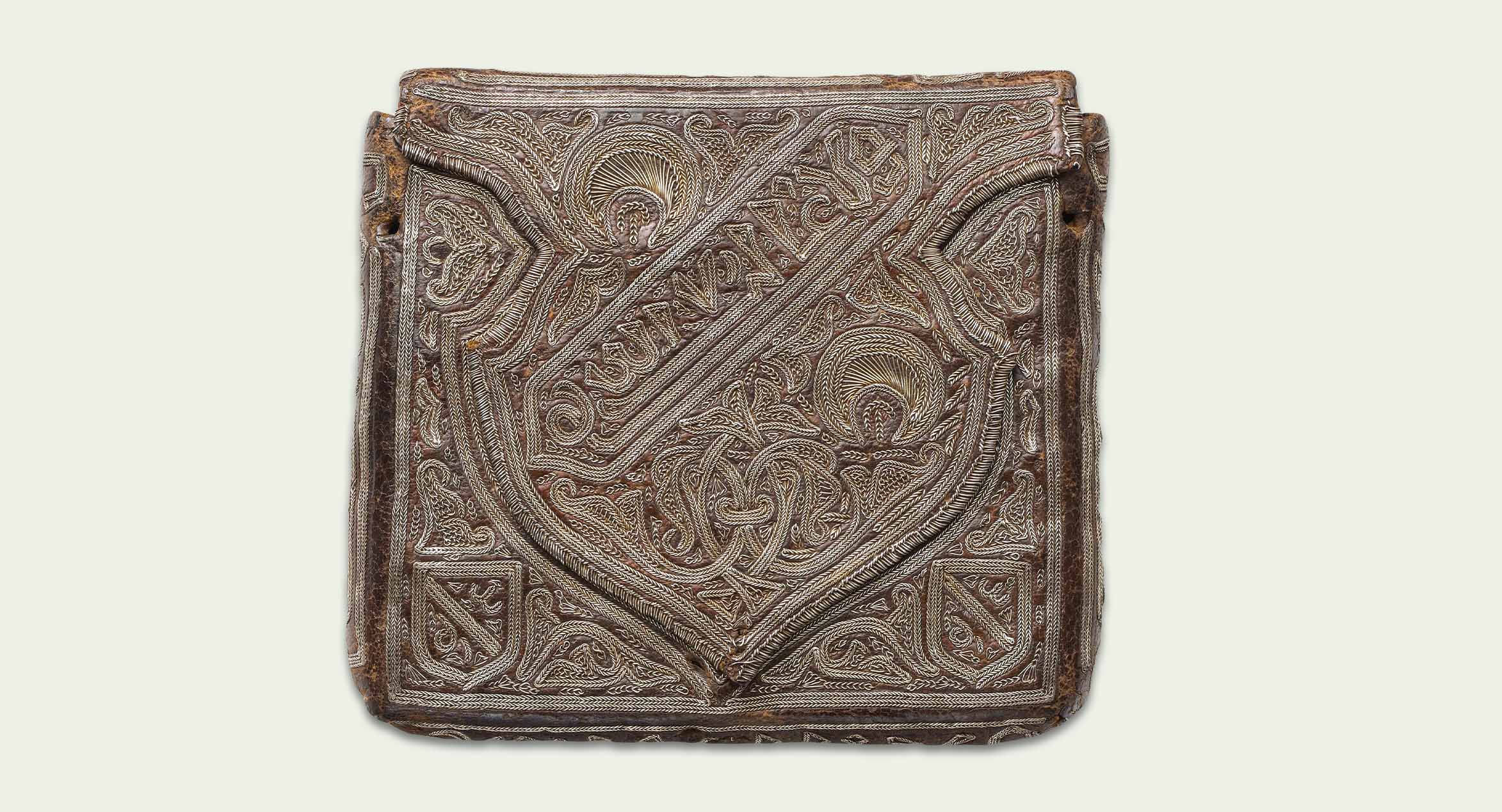
A leather Qur'an case, embroidered with gilt-silver wire and decorated with the Nasrid shield and motto ‘There is no victor but God.’ A piece of paper found inside claimed in French that it belonged to the last sultan of Granada, Mohammed XII. (Getty Images)
A leather Qur'an case, embroidered with gilt-silver wire and decorated with the Nasrid shield and motto ‘There is no victor but God.’ A piece of paper found inside claimed in French that it belonged to the last sultan of Granada, Mohammed XII. (Getty Images)
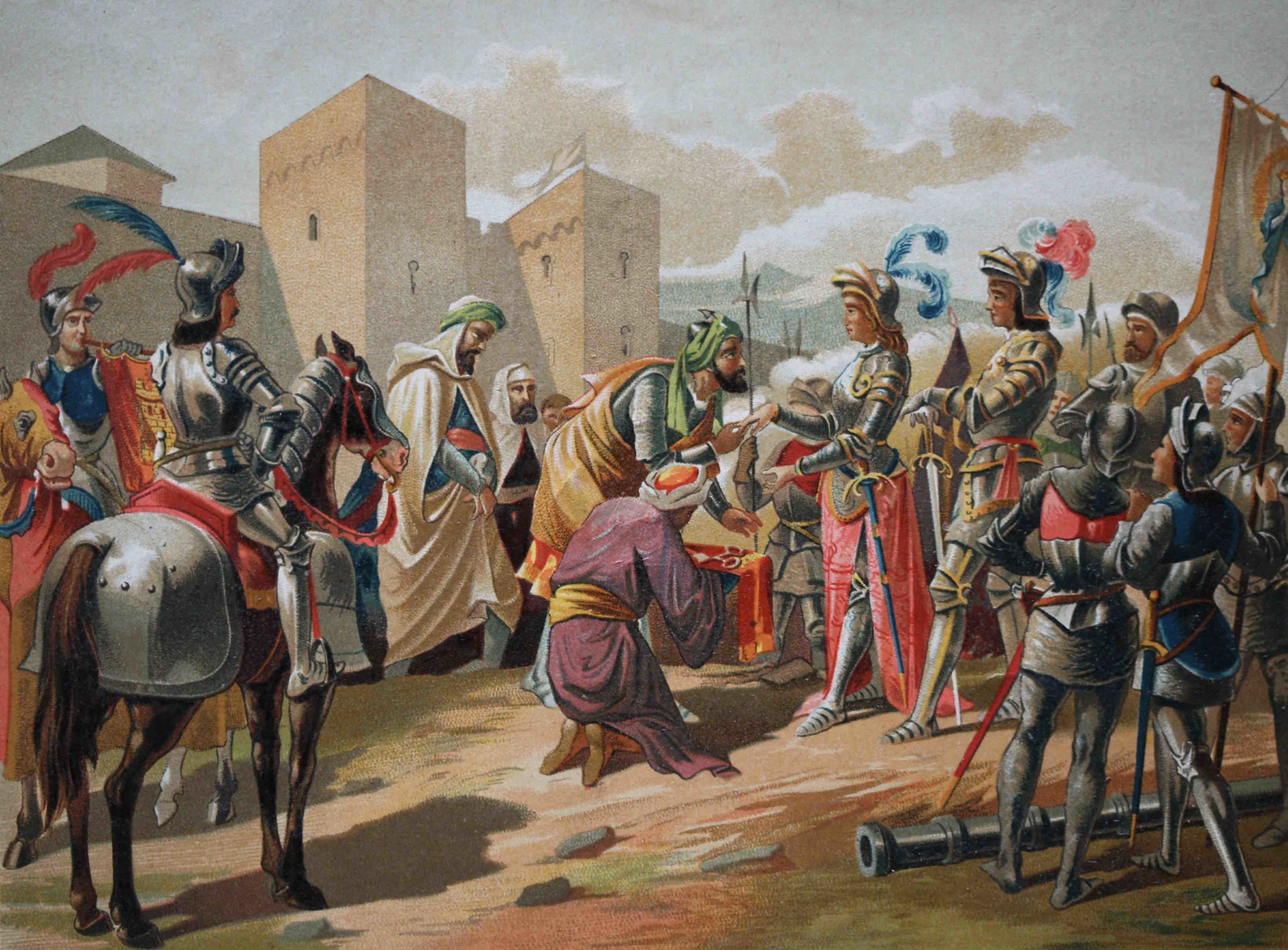
This painting captures the surrender of Granada in 1492, in which it was reported that Boabdil handed the keys to Ferdinand and said: “God loves you greatly. Sir, these are the keys of this paradise. I and those inside it are yours.” (Alamy)
This painting captures the surrender of Granada in 1492, in which it was reported that Boabdil handed the keys to Ferdinand and said: “God loves you greatly. Sir, these are the keys of this paradise. I and those inside it are yours.” (Alamy)
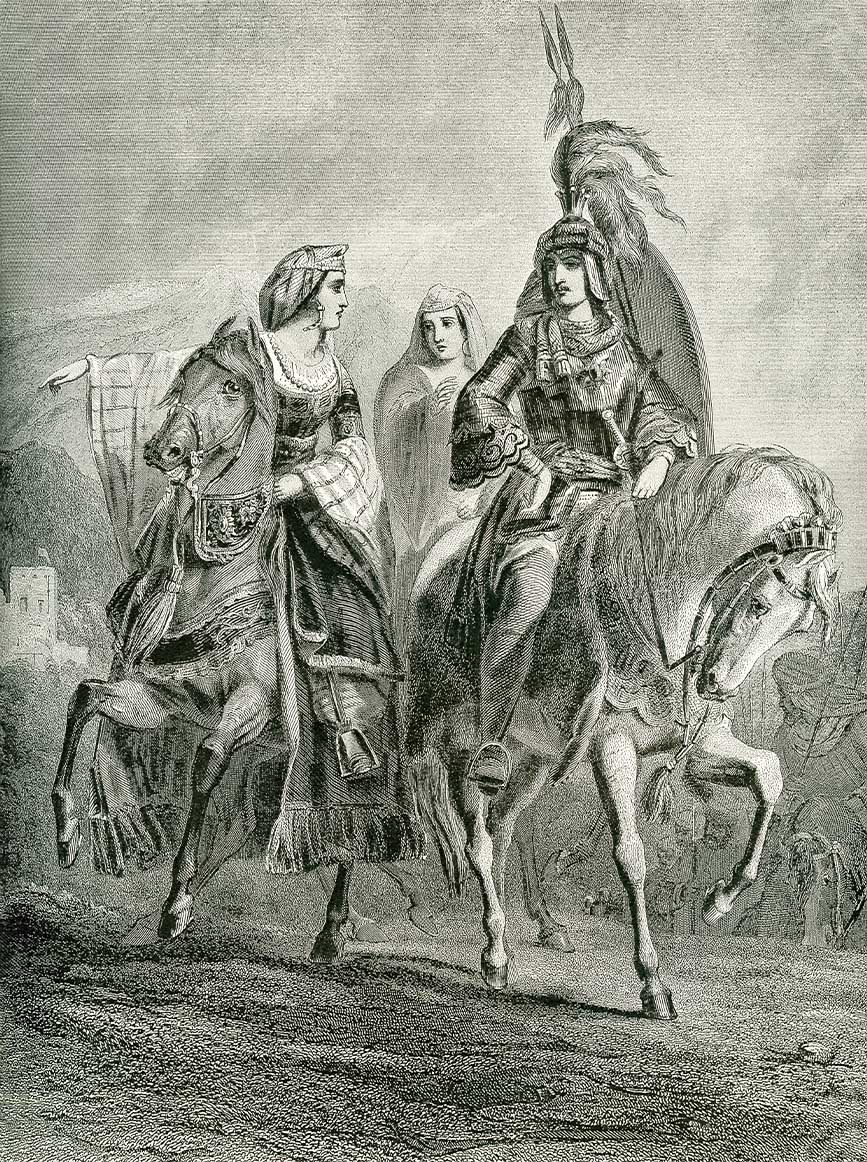
This 1892 illustration shows Boabdil bidding farewell to Granada. With him are his wife and mother. (Alamy)
This 1892 illustration shows Boabdil bidding farewell to Granada. With him are his wife and mother. (Alamy)
By the late 1080s, it had become apparent to the taifa princes that each of their small independent territories could not hope to hold out against the might of the expanding northern Christian kingdom of Leon and Castile. The cost of the parias, the tributes they were forced to pay, had become ruinous and the fate of those taifas that failed to contribute to the royal coffers became clear in 1085, when Alfonso VI seized Toledo and Madrid, adding them to his kingdom.

An undated illustration shows King Alfonso VI of Leon and Castile entering Toledo in 1085. (Getty Images)
Fearing their lands would be the next to fall, the rulers of several taifas, including Seville and Granada, appealed for help to the Berber Almoravid dynasty, which had expanded throughout the western Maghreb from its base in Marrakech.
In July 1086, a large force under the Almoravid ruler Yusuf ibn Tashfin landed at Algeciras, where it was joined by the troops of five taifas, and in October the same year defeated the Castilian army of Alfonso VI at the Battle of Sagrajas.

A 19th-century engraving of the Battle of Sagrajas (1086) between the Almoravid army led by Yusuf ibn Tashfin and the Christian army led by the Castilian King Alfonso VI. (Getty Images)
The victory did not dislodge the Christians from Toledo, partly because Yusuf had to sail back to Morocco to deal with a family crisis. When he returned to Al-Andalus in 1088, he found that many of the taifas had turned their backs on the Almoravids and had sought the renewed protection of Leon and Castile.
The Almoravids turned on their former allies, and by the end of 1090 they had seized all of the southern taifas. Over the next few years the Christian forces were defeated in a series of battles, culminating in the Battle of Ucles in 1108, and the reconquista ground to a halt.
But it was only a temporary reprieve. Under Yusuf’s successor, his son Ali ibn Yusuf, the Almoravids, harried at home by the growing power of the rival Almohad dynasty, founded by an alliance of Berber tribes in the Atlas Mountains of what is today Morocco, steadily began to lose ground to the Christians in Al-Andalus. The sun finally began to set on the Almoravid era with the fall of their capital, Marrakech, in 1147.
By then, Al-Andalus had once again begun to fragment into small taifas, and for a while it seemed that the future of the Muslim presence in Iberia was once again in the balance. This time, however, it was the turn of the Almohads, by now dominant across all of Northwest Africa, to seize power across the Mediterranean and keep the banner of Al-Andalus flying.
In a lengthy campaign that began in 1146 under the caliph Abd Al-Mu’min and lasted almost 30 years, the newcomers slowly drove out the remnants of the Almoravids, in the process moving the capital of Al-Andalus from Cordoba to Seville, where they began the construction of a great mosque.
Almost nothing of the mosque itself remains — after the Christians took the city in 1248, it was replaced with a cathedral — but for its spectacular minaret, La Giralda. Converted and adorned with Christian iconography during the 16th century, it now serves as a belltower for the cathedral, but the glory of the original building is still apparent.

The Giralda Tower, once a minaret, is all that remains of Seville's mosque, which was replaced with a cathedral after the Christians took over in 1248. (Getty Images)
The Almohad dynasty survived for three more generations. During that time, the caliphs treated Al-Andalus as a province, venturing across the Mediterranean only rarely. When they did, there were military successes against the Christians pressing from the north. In 1189, Abu Yusuf Yaqub Al-Mansur recaptured the city of Silves, in modern-day southern Portugal, and in 1195 returned to shatter an ambitious advance on Seville by Alfonso VIII of Castile.
The Battle of Alarcos, in which the Castilian army was destroyed and many of the Christian kingdom’s leading figures killed, appeared to turn the tide of fortune once again in favor of the Muslims. Several Christian cities were captured and, for a while at least, Al-Andalus was safe.
But, once again, the respite proved short-lived.
Al-Mansur died in 1199 and his successor, Mohammed Al-Nasir, was unable to emulate his success. In 1211, in a bid to rid the province of the Christian threat once and for all, he led a strong army across the Mediterranean. This time, however, the Christians were ready, and Al-Nasir was heavily defeated by an overwhelming alliance of forces from Castile, Navarre and Aragon.
The Battle of Las Navas de Tolosa, known in Arabic as the Battle of Al-Uqab, was a turning point in the fortunes of the Almohads.

The Battle of Las Navas de Tolosa, the subject of this 19th-century painting, was seen as a turning point in the fortunes of the Almohads. (Alamy)
Within a decade, they had been overthrown at home in the Maghreb and the Christians had captured numerous cities in Al-Andalus, including Cordoba, Seville, Jerez, Cadiz and Valencia, and the Balearic Islands.
After the fall of the Almohads, the stage was set for the last act in the story of the Muslim conquest of Iberia, and the entrance of the last Muslim dynasty to rule in Spain.
At this stage, wrote the historian Elizabeth Drayson in her book “The Moor’s Last Stand,” “it looked very much as if Islamic life in the peninsula was about to founder.” But then, in 1232, a new Muslim dynasty emerged, founded by Mohammed ibn Yusuf ibn Nasr, a local leader in the small town of Arjona, some 80 kilometers northwest of Granada.
Within five years Mohammed I, as he had now styled himself, had made Granada the capital of his new Nasrid dynasty. Territorially, his Emirate of Granada in southern Iberia was a besieged shadow of the former caliphate of Al-Andalus. But, “defying all expectations,” it “became a brilliant success (and) he created a dynastic line that secured the presence of Islam in Spain for over 250 years at a time when its future seemed doomed.”
For Mohammed and his successors, who would maintain the fragile existence of Granada against the odds for the next two and a half centuries, the name of the game from the outset was compromise.
For Mohammed and his successors, who would maintain the fragile existence of Granada against the odds for the next two and a half centuries, the name of the game from the outset was compromise. Mohammed’s first major political act was to agree a peace settlement with Castile, under which he paid tributes and acknowledged that the Emirate of Granada was a vassal state.
But in truth, wrote Drayson, “the Granadan state never accepted subordination to Castile. The status of vassalage was an on/off affair, initially for only twenty years and subsequently renewed and rejected many times by the rulers of Granada in the long history of fighting between the sides, often fuelled by the emir’s support of Muslim rebels in Christian territories.”
Nevertheless, by 1492 the great game was up.
In 1482, Abu Abdallah Mohammed XII — known in the West as Boabdil, a corruption of his name — had become the 22nd and last ruler of the Emirate of Granada.

Mohammed XII, also known as Boabdil, the ultimate ruler of the Nasrid Emirate of Granada. (Alamy)
During a bold but rash assault on the Castilian town of Lucena the following year, he was captured and released only after handing over hostages, including his son Ahmed, and swearing allegiance and pledging to pay tributes in gold and silver to the Catholic monarchs Queen Isabella of Castile and Ferdinand II of Aragon.
The clothes and weapons said to have been taken from Boabdil after his capture can be seen today in the Spanish Army Museum in Toledo.

This helmet is said to have belonged to Boabdil, last Nasrid king of Granada. It is the only known example of armor to survive from the Nasrid period in Spain. (Getty Images)

A leather Qur'an case, embroidered with gilt-silver wire and decorated with the Nasrid shield and motto ‘There is no victor but God.’ A piece of paper found inside claimed in French that it belonged to the last sultan of Granada, Mohammed XII. (Getty Images)
Released, but finding himself challenged in his absence for the leadership of the Emirate of Granada by his father and uncle, it was 1487 before Boabdil regained his throne. By then, the regional dynamics that had obliged the Catholic monarchs to put on hold their ambition to reconquer the whole of Iberia had changed, and over the next four years the noose around Al-Andalus grew ever tighter.
By the winter of 1491, Boabdil had come to recognize the inevitable — women with starving children in their arms were begging for food in the streets of Granada — and began negotiations with the enemy.
Among many other conditions he sought in exchange for the surrender of the city and an end to the bloody fighting, he insisted that all Muslims should be allowed to keep their religion, that the muezzin’s call to prayer should continue for all time and that there should be no forced conversions to Christianity.
He also stipulated that Jews living in Granada, who had had equal rights in the emirate, should enjoy the same protection as Muslims after the surrender.
Believing he had got the best deal he could under the circumstances, on Jan. 2, 1492 Boabdil rode out of the city and handed the keys to Ferdinand and, if the Christian chroniclers of the historic event are to be believed, said in Arabic: “God loves you greatly. Sir, these are the keys of this paradise. I and those inside it are yours.”

This painting captures the surrender of Granada in 1492, in which it was reported that Boabdil handed the keys to Ferdinand and said: “God loves you greatly. Sir, these are the keys of this paradise. I and those inside it are yours.” (Alamy)
Boabdil settled in exile, as agreed, on an estate in Laujar de Andarax, 60 kilometers southeast of Granada in Almeria’s Alpujarra region, but he did not stay there long, requesting that he be allowed to leave for North Africa instead, where the King of Fez had granted him permission to settle.
Boabdil and his retinue left on a small fleet of ships. The precise date is lost to history, but they sailed away from the port of Adra, where Abd Al-Rahman I, founder of the Umayyad Emirate of Cordoba and father of the golden age of Muslim culture in Spain, had landed seven centuries earlier.

This 1892 illustration shows Boabdil bidding farewell to Granada. With him are his wife and mother. (Alamy)
Boabdil’s wife Moraima did not go with him. She had died in August and, according to some sources, her body was left behind on Spanish soil, in the Nasrid ancestral cemetery in Mondujar.
According to the 17th-century Algerian historian Ahmad ibn Mohammed Al-Maqqari, Boabdil settled in Fez, where he was said to have had a palace built in an area known today as the Andalusian quarter — an area where many Muslim refugees from Christian rule in Iberia settled after 1492.
This, according to Al-Maqqari, was where the last king of Al-Andalus died, at the age of about 72, in either 1523 or 1524. Boabdil’s remains are said to lie under the dome of a small, neglected building on the outskirts of Fez.
Within a decade of Boabdil leaving Al-Andalus, Isabella and Ferdinand had reneged on most of the terms he had insisted upon to secure the protection of Muslims and Jews under the new Christian regime.
On March 31, 1492, barely three months after the fall of Granada, the Catholic monarchs signed a law at the Alhambra ordering all Jews in their kingdoms to convert to Christianity or leave for good within four months.
According to “History of a Tragedy,” the 2007 book by French historian Joseph Perez, over the previous century tens of thousands of Jews in the Catholic kingdoms had already converted to Christianity in the face of ongoing persecution. Now those who had lived under the protection of the Muslims in Al-Andalus found themselves placed in an impossible situation, which for many ended in disaster.
The 15th-century Spanish priest and historian Andres Bernaldez described the exodus in his book “Memories of the Reign of the Catholic Monarchs.” The Jewish refugees, he wrote, “went through roads and fields with many travails … some falling, others rising, others dying, others being born, others falling sick, so that there was no Christian who did not feel sorry for them and always invite them to be baptized.”
Only some, he added, “sorrowfully converted, but very few.”
For Carr, writing in “Blood and Faith,” “the brutal extirpation of Spanish Jewry dealt a fatal blow to the legacy of medieval coexistence,” and soon enough it would be the turn of Spain’s Muslims to suffer intolerance at the hands of the Catholics.
The rights that supposedly had been secured by the capitulation agreement in 1492 quickly began to be eroded. In breach of the agreement that Muslims should be allowed to live true to their faith, under a religious tyranny imposed by Francisco Jimenez de Cisneros, the archbishop of Toledo, and endorsed by the Catholic monarchs, many were pressured or even forced to convert, an outrage that provoked a series of brief but bloody revolts in and around Granada.
Granada had undergone the trauma of war and conquest, followed by a bloody rebellion and the mass conversion of its population to Christianity.
By 1502, it was all over. In two decades, wrote Carr, “Granada had undergone the trauma of war and conquest, followed by a bloody rebellion and the mass conversion of its population to Christianity” — a population now known, in the terminology of the times, as “Moriscos.”
After 800 years of settlement, it must indeed have been traumatic for a people whose families had known no other home for generations — but Catholic Spain was not yet done with its “Moriscos.”
In the spring of 1609, Philip III of Spain ordered that all descendants of the Muslims who had been forced to convert to Christianity a century or more before should be expelled from the kingdom. By 1611, as many as a million had been driven out, to settle mainly in the Maghreb.
Some, born and raised in Iberia as generations of their family had been before them, found the North Africa of their distant forebears to be an inhospitable, alien land, and managed to return to Spain, disguising their origins. Thousands more may have evaded expulsion altogether, with some continuing to practice their religion in secret.
Either way, the result was a suppression of Muslim identity in Spain and a denial of a culture that revolutionized thought and progress in Europe and continues to shine through to this day in the language, art, architecture and even the genetics of the population of modern-day Spain.
The last of the Andalusians
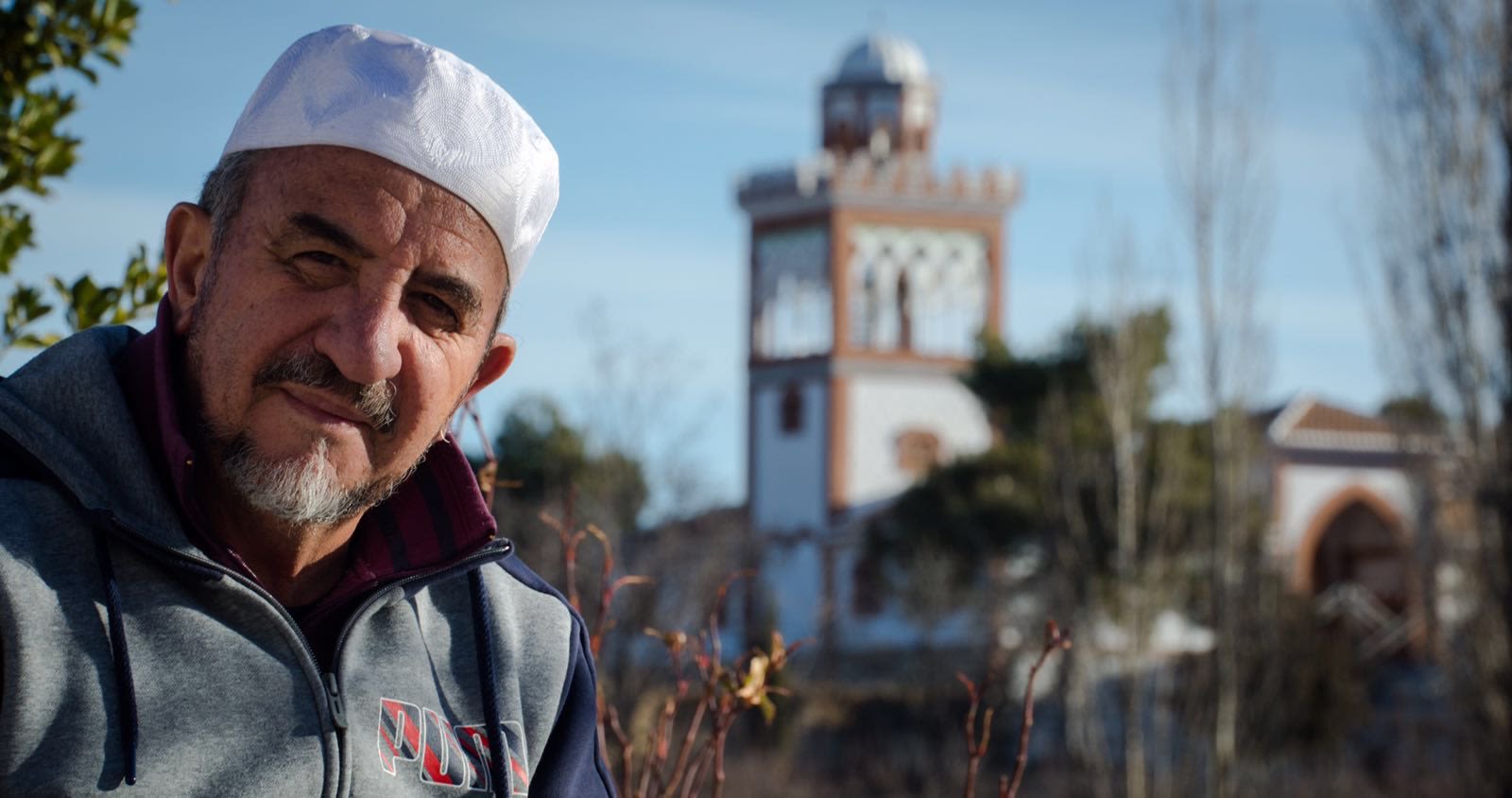
Back in the 1990s, 13-year-old Cyrine Sanchou traveled to Spain with her family from their home in Tunisia. Arriving by boat in Cadiz, they were taken aback to be greeted by a large sign in Spanish that read: “Welcome to Sancho’s house.”
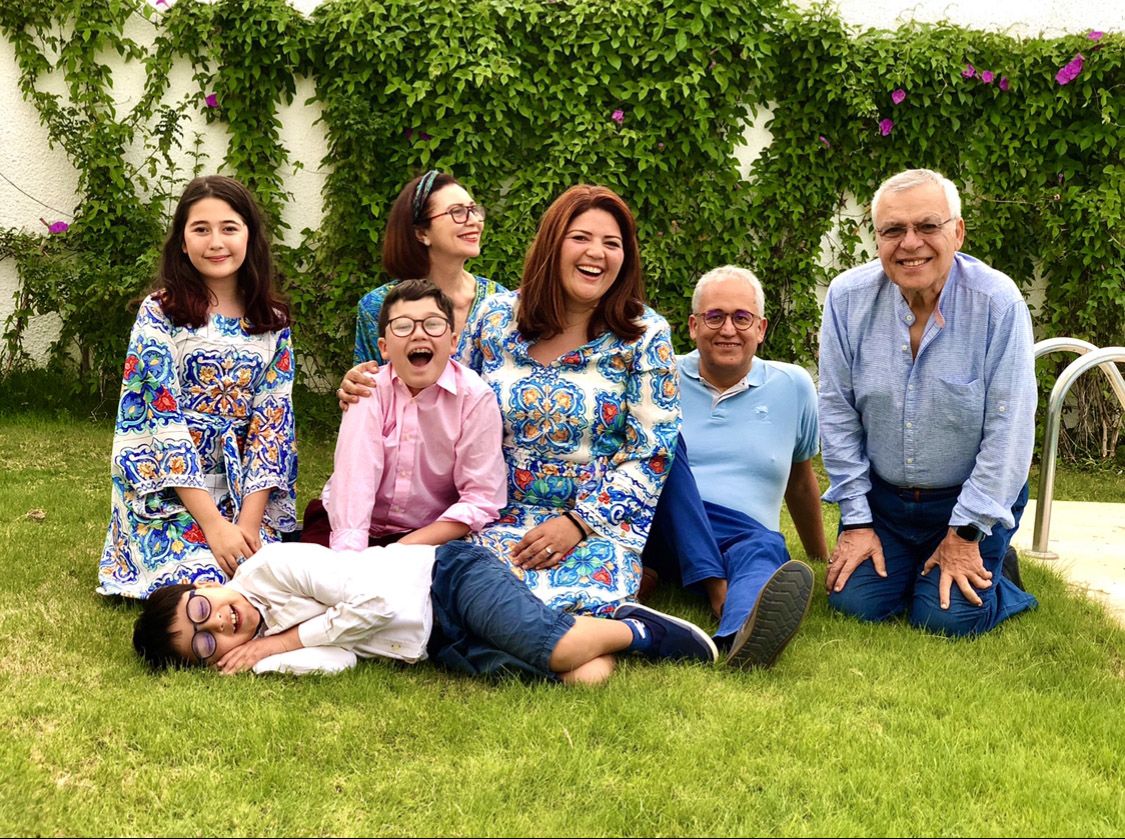
Cyrine Sanchou, center, with her parents, husband and three children, are among the last of the Andalusians. They live in Tunisia but have visited Spain.
“I remember crying a lot,” she recalled. “It was just a billboard for a hotel called Sancho’s House, but for us the symbolism was enormous.”
For the Sanchou family, who claim descendancy not only from the Muslims driven out of Spain more than 400 years ago but also from the original Arab occupiers of Iberia in the eighth century, the billboard seemed to celebrate a long-overdue homecoming.
“According to a former Spanish cultural official who was a friend of my grandfather, the only Muslim descendants with the name Sancho are the descendants of Abd Al-Rahman Sanchuelo,” said Sanchou, now 44, whose brand The Red Bee promotes Tunisian craftsmanship.
Historians recorded that Sanchuelo, who died in Cordoba in 1009, was the son of Mohammed ibn Abi Amr Al-Mansur, who served as the chancellor of the Umayyad caliphate of Cordoba in the 10th century and organized numerous attacks on the expanding Christian kingdoms to the north.
Sanchou and her family, like those in many communities across North Africa, are in no doubt that they are among the last of the Andalusians, part of the great Muslim diaspora scattered to the winds in the centuries after the fall of Al-Andalus in 1492.
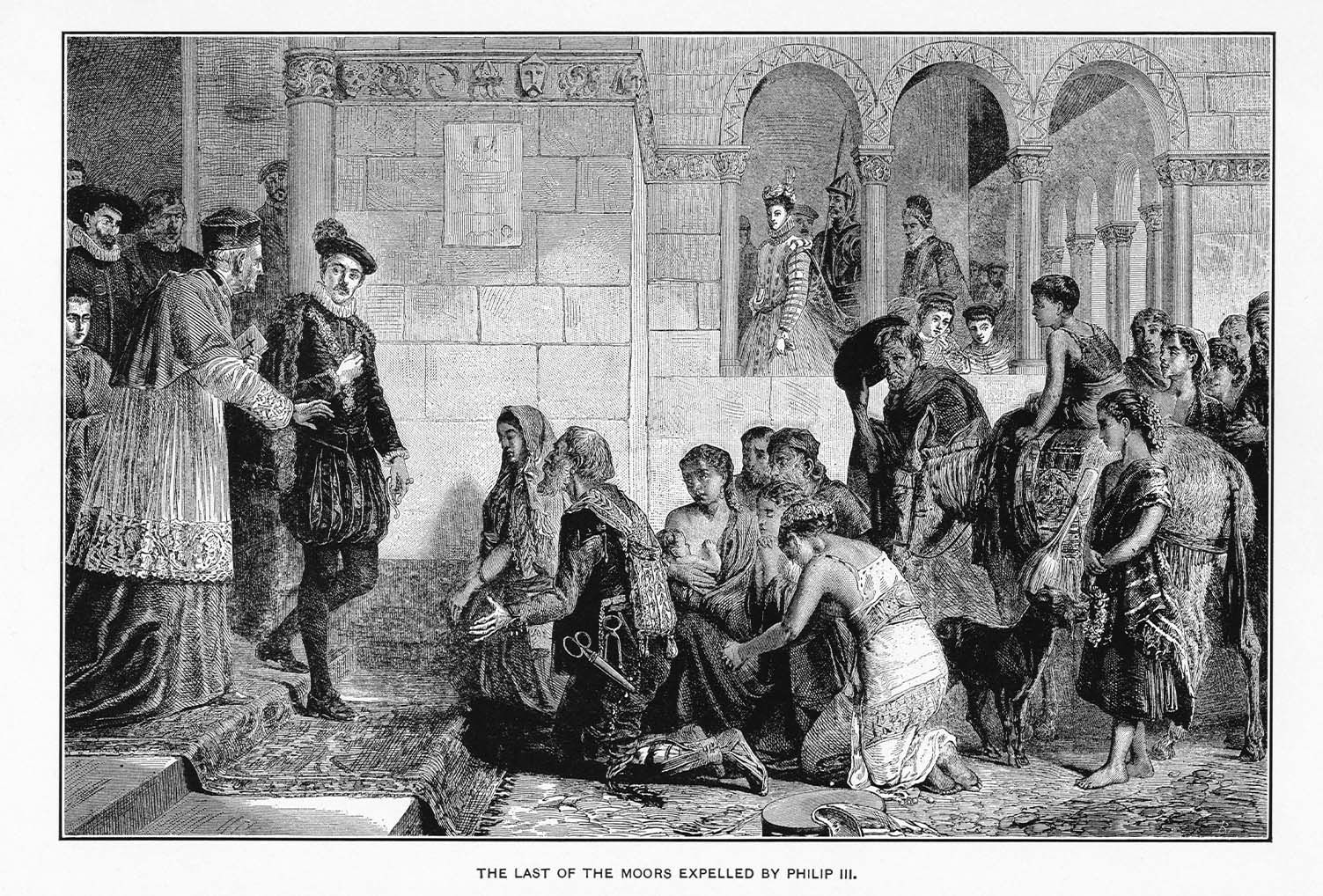
An engraving depicts Muslims expelled from Spain by King Philip III. (Getty Images)
Her family has carried out years of research, inspired by the work of the renowned Tunisian historian Abdeljelil Tamimi, a specialist in historic documentation related to the Maghreb and author of the 2011 book “Tragedy of the Moorish Expulsion.” As a result, the family has built up a convincing picture of its journey through time.
Sanchou said her forebears arrived in Tunisia by boat after fleeing Spain in April 1609 and were given accommodation in a district already populated by refugees from Al-Andalus. This, she believes, “proves that their profession in Spain was probably in an intellectual or artisanal field because otherwise they would have been assigned to other towns or villages in Tunisia.”
Although now a partial ruin, the house still belongs to her family, which has a copy of the original bill of sale.
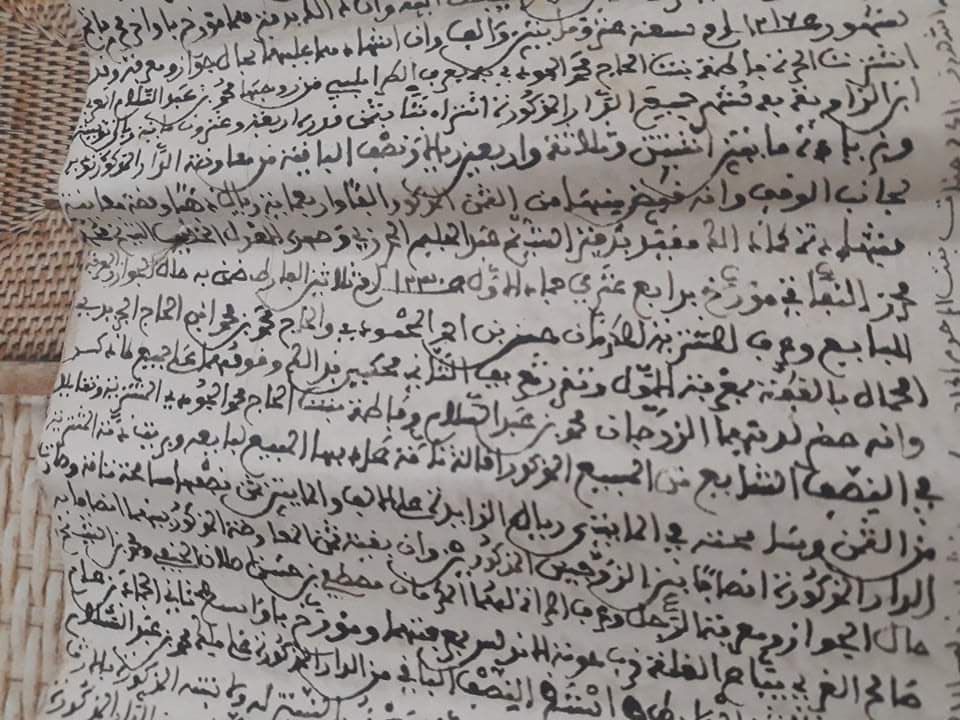
Cyrine Sanchou’s family has a copy of the original bill of sale for “Sancho’s house” back in Spain, now a partial ruin. (Supplied)
Sanchou’s research has led her to the conclusion that her family’s roots can even be traced back to Yemen, to “the family of Abd El Malek Banu Ma'afir, who fought alongside Tariq ibn Ziyad for the conquest (of Iberia) in 711.”
In Tunisia, said Sanchou, “we are surrounded by families from the Moriscos. My family until my grandfather were all blond, very white-skinned and blue-eyed. It is only for two generations that we have more of the features of North Africa because for centuries the Moors of Tunisia married their children to descendants of the Moors to preserve the genes.”
Although for some today the word “Moor” (or “Moro” in Spanish) has acquired a derogatory tone, others claim it for themselves with pride or apply it to others with respect. The term was derived originally from the Greek word “Mavro,” meaning black, which was then adapted by the Romans as “Mauri” in reference to the peoples of North Africa and which formed the basis of the name of the Roman province Mauretania. In time, the word became anglicized as “Moor,” a term applied to Berbers and Arabs alike.
With the distance of great time and the fog of uncertainty created by the determination of the reconquista’s architects to erase the records of Spain’s rich Muslim past, it is difficult to separate fact from fiction in the poignant legends that have risen among the many communities in countries such as Tunisia, Algeria and Morocco, said to have been founded by Muslim refugees from Al-Andalus.
Such legends are evident, for example, in the keys that hang on the walls of homes in Rabat, Morocco, where many Andalusians settled after being driven out of Spain in the 17th century — a tradition echoed in more recent times by Palestinian families driven into exile in 1948.
An academic paper in 1995 quoted a man in his eighties who spoke of old people who stood on the Moroccan shore and “nostalgically look to Spain for a sign that they can return.” The keys they kept in their homes, he said, were the keys to the properties their families once owned in Al-Andalus. They still hoped “to one day return and open the old doors.”
Other stories speak of mysterious remote villages in Spain where generations of Muslim families have lived for centuries, practicing their religion in secret for fear of reprisal and even now, long after the threat of persecution has passed, living clandestine lives of faith cut off from the outside world.
True or not, such tales speak at the very least of the survival of a great yearning for, and a strong sense of connection with, the lost Islamic kingdom of Al-Andalus.
In a University of Pennsylvania PhD dissertation published in 1995, anthropologist Beebe Bahrami investigated “how an historical identity persists within a community in Rabat, Morocco, that traces its ancestry to Spain.”
Bahrami carried out ethnographic and historical archival research among Rabati Andalusian families whose forebears “came to Morocco as Muslim refugees from a violent Cordoba (early 11th century), as Muslim refugees from a Granada (re-)conquered by Christians in 1492, or as baptized crypto-Muslims or true Christians from the 1609 expulsions.”
She found that much Spanish had been spoken in the Rabati dialect “well into the 1800s,” and that “even today there are a few words, perhaps 150, pointing to Spanish origins.”
The oral histories of the Andalusians of Rabat that she explored “consistently pointed to the fact that cultural differences maintained within the Andalusian families” had “kept [them] separate from the rest of society,” and that “the Moroccan Andalusian identity never waned.”
This was partly because, over the centuries, the descendants of the original Andalusians had practiced endogamy, the custom of marrying only within a specific cultural group.
This cultural isolation, Bahrami concluded, was likely tolerated “because other Moroccans valued the Andalusian traditions and also sought to adopt many of them for themselves.”
For Sanchou, and for many thousands of others like her, “my dream, one day, is to return to the land of my ancestors and buy a piece of land or a house there to appease the fire of the suffering and humiliation felt by my ancestors who were tortured, dispossessed…and driven out like rubbish from a country that had been theirs for eight centuries.”
In 2003, one house was opened in Granada that seemed to offer hope that such dreams might one day come true — a house of God.
On Thursday, July 10, 2003, a muezzin called the faithful to prayer for the first time at the Grand Mosque of Granada, the first to be built in the city since the fall of Al-Andalus.
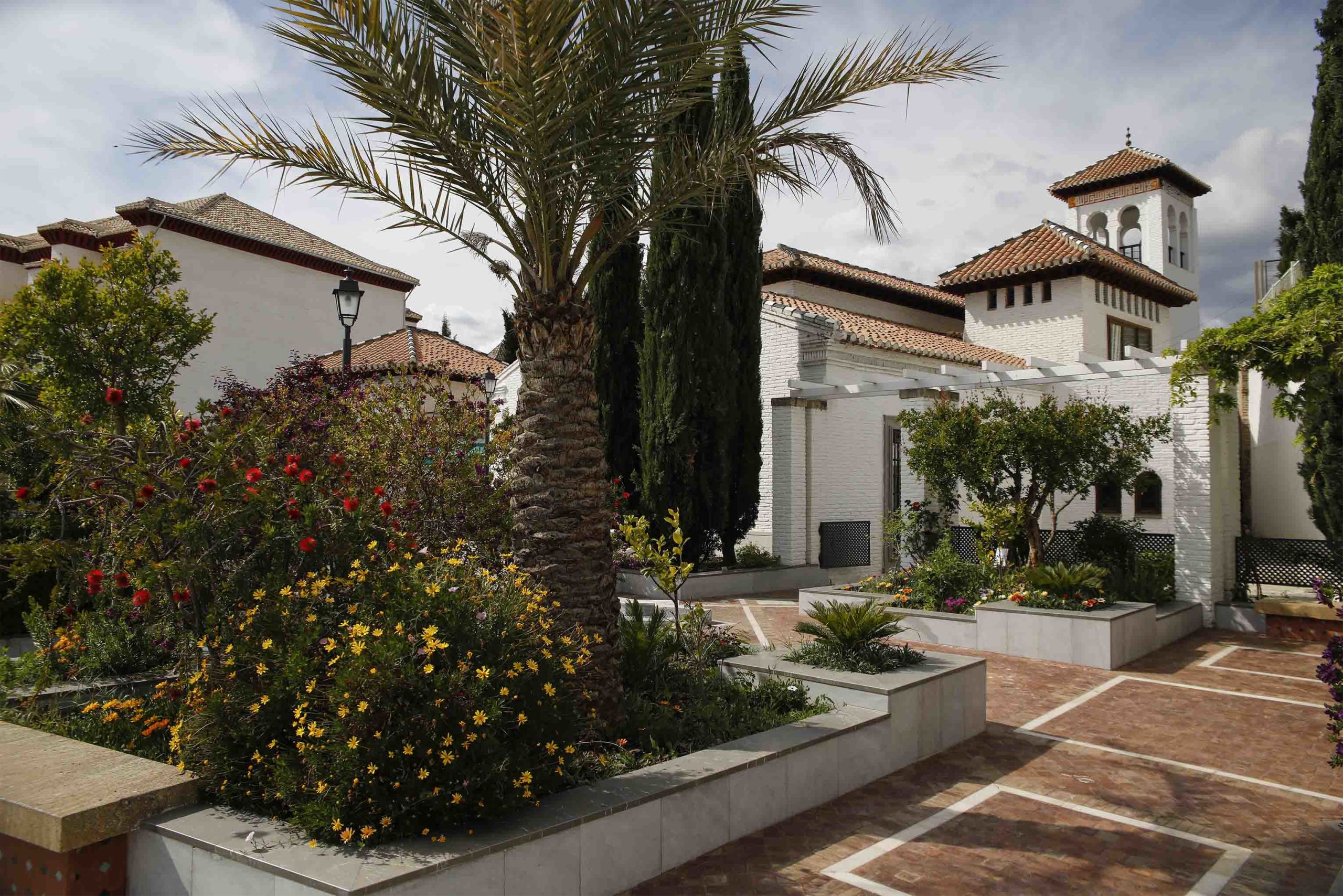
The Great Mosque of Granada, built with funding from the UAE and Morocco in 2003, was the first mosque to open in the area since the fall of Al-Andalus. (Getty Images)
At the time, a spokesman told the media that the mosque was “a symbol of a return to Islam among the Spanish people and among indigenous Europeans that will break with the malicious concept of Islam as a foreign and immigrant religion in Europe.”
The beautiful mosque, built with funding from Morocco and the UAE, would “act as a focal point for the Islamic revival in Europe.”
Overlooking the Alhambra, abandoned by Mohammed III in 1492, it also served as a reminder of the eight centuries of Muslim rule in Al-Andalus.
We visited Ibrahim Perez, a first-generation Spanish Muslim convert, at the Grand Mosque in Granada, where he spoke about its place in the community.
Not everyone welcomed the construction of the Grand Mosque, which was not quite as grand as it might have been. During the two-decade struggle to persuade city authorities to approve its construction, its designers were obliged to reduce the height of the minaret so it did not stand taller than the tower of the nearby Catholic Church of Saint Nicholas.
Modern Spain, said Antonio Manuel Rodriguez Ramos, a professor of civil law at the University of Cordoba, is a nation “that oscillates between two notions: those of us who defend diversity as the true essence of its history, and those who intend to build their identity by rejecting it.”
For the latter, he said, “everything ends with the Castilian and Catholic conquest. It is true that they tried to impose a single religion, with only one skin color, and that is why they persecuted Jews and Muslims, gypsies and blacks, and it is true that many fled to save themselves from this human and cultural extermination.
“But it is also true that a large part of the population remained, sometimes doing what their predecessors did until they forgot why. Hundreds of words and customs are Andalusian. These Moorish and Andalusian footprints have shaped the identity of Andalusia and demonstrate on their own that the expulsion has failed, that the attempt at cultural homogenization has failed, and that the Spanish identity forged on the extermination of the different has failed.”
Ramos is the author of two books that, he said, are “a mirror of the soul”: “The Moorish Footprint — The Andalus We Carry Inside,” and “Flamenco: Archaeology of the Jondo,” the jondo being a flamenco vocal style rooted in Al-Andalus.
The books, he said, ask us “to recognize ourselves within and discover this hidden truth in the words, in the way we pronounce them, in our way of feeling, singing, dancing, eating or living.
“Those who read them immediately recognize themselves in them. They discover why their parents washed as Muslims before going to eat, without knowing it; that their mothers cleaned their houses on the Sabbath so as not to look Jewish; that the tapas were of pork and wine so they wouldn’t be accused of being heretics; that the solea is the call to prayer or the martinete (a type of flamenco song) the iqama that they did hidden inside their houses, their huts or their caves.”
If the ruling demanding that the minaret of the Grand Mosque of Granada should not overshadow the nearby church reflected a lingering ambivalence toward Spain’s Muslim heritage, then a unanimous decision by the Spanish parliament in 2015 to invite the descendants of Jews expelled from Spain to apply for citizenship — but not Muslims — appeared to be a slap in the face of history.
After centuries of “estrangement,” Spain was now inviting Sephardic Jews — the descendants of the Jews driven out of the country in the 15th century — “to re-encounter their origins, opening forever the doors of their homeland of old.”
Applicants had to offer documentary proof of Sephardic status, such as a certificate issued by the Federation of Jewish Communities of Spain, a birth or marriage certificate proving celebration in the Castilian Jewish tradition or a report “produced by the appropriate entity that proves the applicant’s membership of the family names to the Sephardic lineage of Spanish origin.”
The window for applications closed on Oct. 1 last year. According to a spokesman for the Spanish Office for Diplomatic Information, “up to 132,000 persons of Sephardic origin have demanded the Spanish nationality through the specific law approved for the purpose.”
But what of the descendants of Spain’s forcibly converted or exiled Muslims?
“With regards to people who might claim to be descendants of the Muslim populations living in Spain at the time of Al-Andalus,” added the spokesman, “so far there has been no initiative in Parliament to award them Spanish nationality.”
For her part, Sanchou said: “I have not asked Spain to account for all the suffering my ancestors suffered, but I do find it unacceptable that they apologized to the Jews and not to the Muslims.”
She is not alone.
Amal Correon, from Rabat, is one of a group of people from several parts of Morocco, including Tetouan and Chefchaouen, who claim descendancy from Andalusians and “who are fighting for at least the recognition of the first genocide in history. We want to receive the same treatment and recognition by Spain as the Sephardic Jews. Maybe we will get there or maybe our children will, but we will continue to seek justice.”
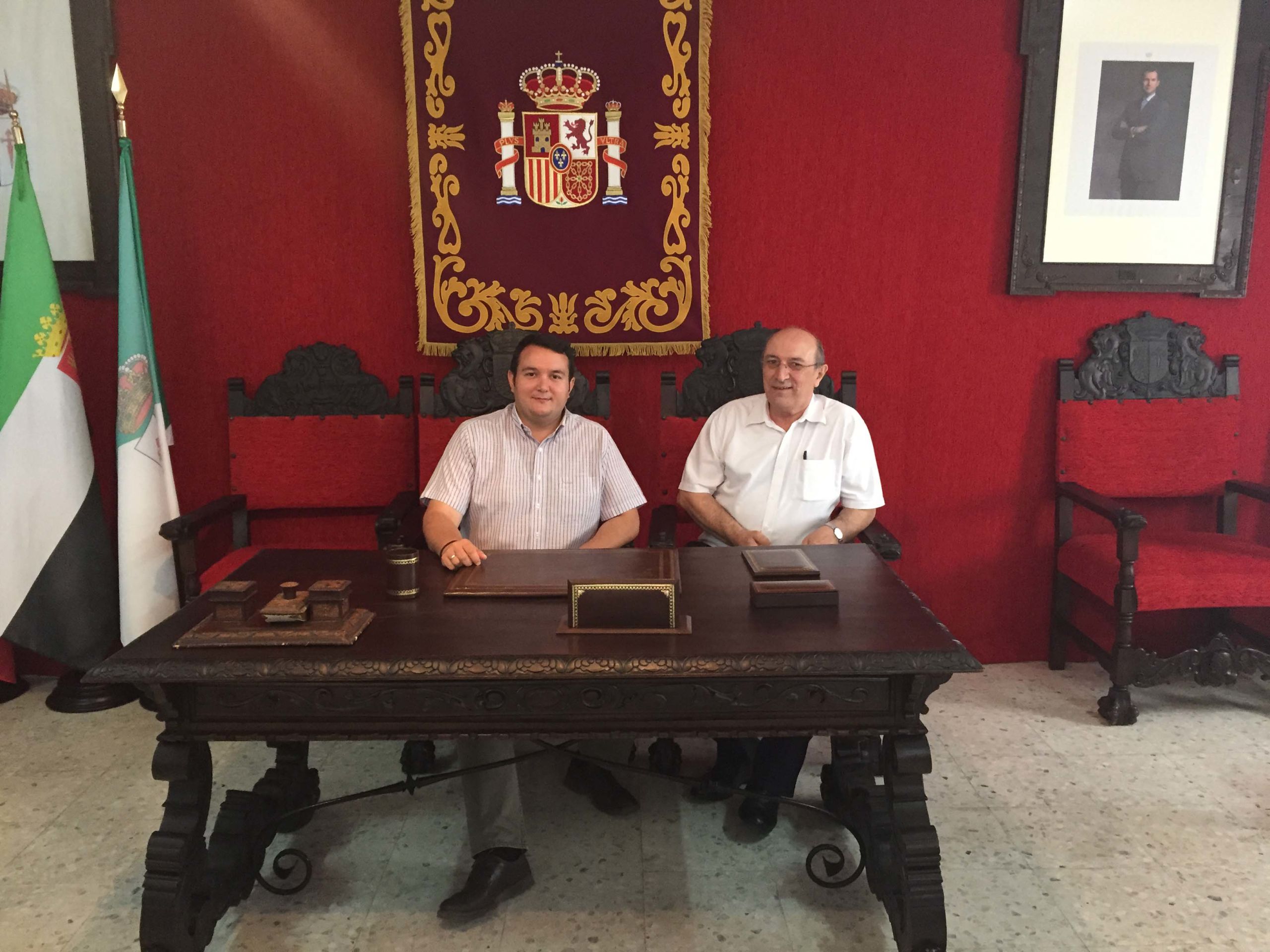
Amal Correon, right, travels to Hornachos from Rabat every year. Here he is with Mayor Francisco Buenavista. (Supplied)
Every year, Correon takes his children on a “pilgrimage” to Hornachos, a small town in the Spanish province of Badajoz, to reinforce the sense of belonging to the place where their ancestors lived and worked for hundreds of years. Overlooking the town are the remains of a castle built by Arabs in the 11th century to mark the boundary between the Muslim taifas of Badajoz and Toledo.
Following the order by Philip III in 1609 to expel the Muslims from Spain, the entire population of Hornachos was evicted. “They had time only to sell what they could sell cheaply and take what they could take with them,” said Correon. His ancestors were among 3,000 or more Muslims who were taken to the port of Seville and put on ships bound for the Moroccan coast.
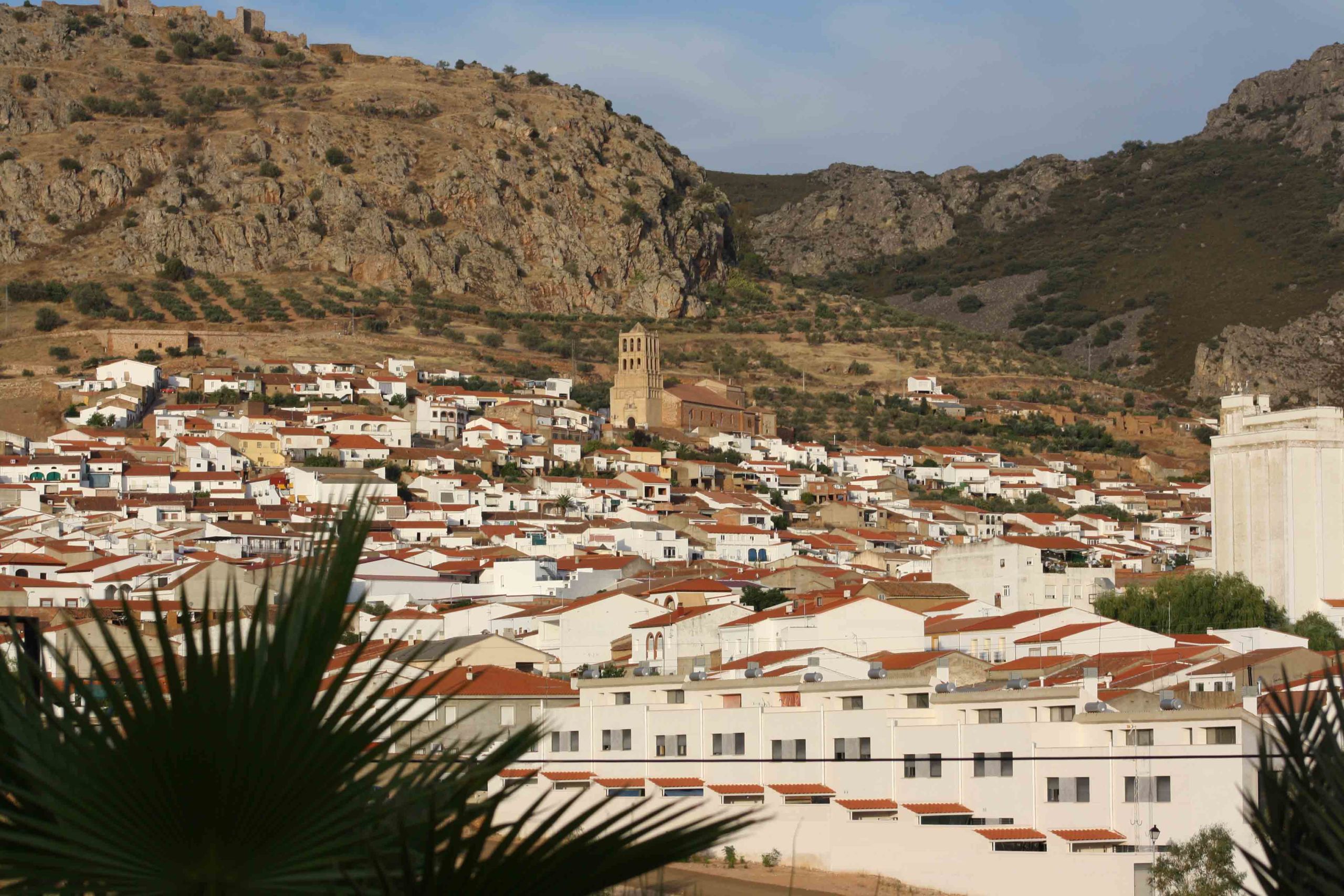
Following the order by Philip III in 1609 to expel Muslims from Spain, the entire population of Hornachos was evicted. (Supplied)
According to research carried out by the late Mohammed Bargach, president of the Rabat Hornachos friendship organization and the Moroccan Genealogy Association, said Correon, “my ancestor Garcia Correon took in charge 500 widows and children for life, until their marriage.”
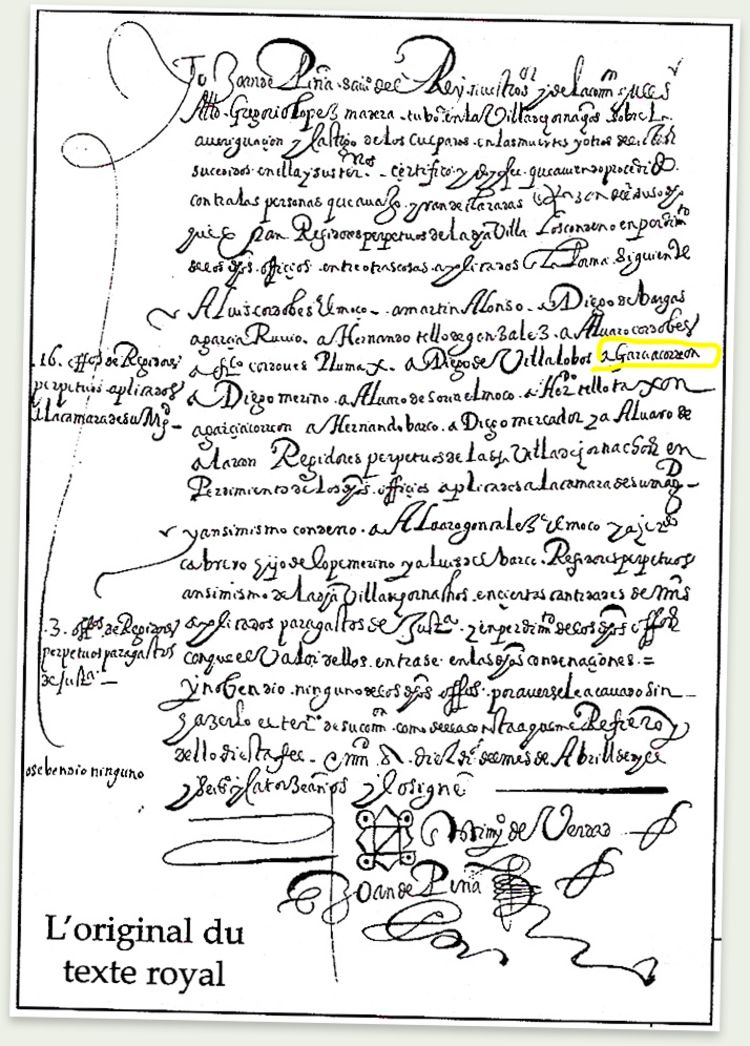
Amal Correon has a document from 1614 showing the name of his ancestor, Garcia Correon, who took charge of 500 widows and their children. (Supplied)
Like many of the refugees, who in Spain had been forced to convert to Christianity, the Hornacheros faced a mixed reception in the ancient land of their ancestors: “Arriving in Tetouan, they were badly received because of their lifestyle, because they were considered too Christian and hardly spoke any Arabic.”
Ever since, said Correon, the Hornacheros have not stopped looking back over their shoulders. “The feeling of belonging to this village is something that only Andalusians know,” he added, being trapped “between the pride of belonging to a category of people who know their origins, proud to bear a name full of history, but also to be a people misunderstood by the ‘natives,’ who considered them as haughty and forming a separate caste, when it was only an instinct of survival, the preservation of identity.”
For some, rediscovery not only of their roots in Al-Andalus but also of their forebears’ faith, has come to them almost as an echo in the soul. Abd Samad Romero, president of the Azzagra Cultural Foundation in the Puebla de Don Fadrique, Granada, was born into a Catholic family in Granada and converted to Islam in January 1980. Over the years, he studied Islam extensively, but it was while on a trip to Morocco that he “found people who were reciting the Qur’an in Rabat,” an experience that profoundly moved him.
Pieces of his family history then began to fall into place. One day, he was teaching his brother how to perform ablution and the movement of salat while his Christian mother watched from a distance. Later that night, “she started to cry, saying that she had seen the same thing when she was little when she used to stay with her grandmother.” It made her realize what an important part of their lives Islam was and how they had to keep it hidden.
His mother “never asked her grandmother what she was doing, and her grandmother never explained it to her or to her mother. She thought it was a danger for her granddaughter to know these things and that with time, when she was older, she would know. And indeed, when she was older, she saw it clearly with us and that’s how she accepted Islam.”
In 1985, at the invitation of Dr. Mohammed Abdo Yamani, then the Saudi minister of Information and Culture, Romero performed Hajj and then moved with his family to Makkah to study at the Umm Al-Qura University. They remained in Saudi Arabia for 12 years before returning to Granada. He began to study his family history and found that they had originated from a Yemeni tribe called the Banu Qasem, who had migrated to Al-Andalus via Madinah.
Abd Samad Romero tells the story of how he converted to Islam, spent time studying in Saudi Arabia and traced his roots to a tribe that migrated to Al-Andalus via Madinah.
In Spain, the Junta Islamica (Islamic Board) has spent years lobbying the government to offer naturalization to the descendants of Muslims evicted from the country after the fall of Al-Andalus. When the offer was made to Jews in 2015, L’Association pour la Mémoire des Andalous in Morocco welcomed it but said the Spanish government should “grant the same rights to all those who were expelled, otherwise the decision is selective, not to mention racist.”
At the time, the association, based in Rabat, claimed that as many as 600 families in Morocco alone today could trace their origins to Al-Andalus.
The Andalusian influence in Granada can be appreciated in a large number of aspects.
Mohammed Escudero Uribe, a member of the Islamic Board in Cordoba, said that for years various groups representing the descendants of the estimated 300,000 Muslims driven into exile “have been trying to promote initiatives aimed at recovering, developing and consolidating the historical memory of the Moors,” as well as seeking from the Spanish state “a historical apology and moral reparation in the name of their ancestors.”
There is, he said, no reason why members of the Muslim diaspora from Spain should not be able to demonstrate their entitlement to Spanish citizenship in the same way that Jews have done.
“These families and groups,” he said, “have been the object of study in universities and research centers aimed at the investigation, analysis and reinterpretation of Moorish history in order to identify and establish genealogical ties and civilizational links.”
The main way to document and demonstrate Moorish origin, he said, “is through genealogical study” — the study of family lineages — “and archival documents, in which you can find textual, legal and historical references that demonstrate the genealogical link of an individual or family today with Andalusian families.”
The descendants who are in Morocco “have also brought their culture, their music, their gastronomy, their way of life,” said Ali Raissouni, a historian in the Moroccan city of Chefchaouen, and “documents signed by judges and notaries, written centuries ago (can be) found in the General Archive of Tetouan or the Royal Library of Rabat, and also in private archives.”
Nisba, adjectival family names indicating a place of origin and often handed down over centuries, can also offer clues, and such names can be found in Rabat — including Al-Andalusi, Al-Ghranati, Al-Cortobi — that indicate a historical link with Al-Andalus.
The Andalusian heritage of Moors who once lived in the Iberian Peninsula and who subsequently migrated, throughout the Middle Ages and up to the 17th century, to North Africa, can also be demonstrated by the study of customs that have been handed down over generations.
Other tools, said Uribe, include “modern genetic studies, which can also help to demonstrate the ancestry and genealogical link of a Moroccan or Tunisian with their Moorish ancestors.”
Both Jews and Muslims have left their mark on the genetic composition of the modern-day Spanish population.
In a study published in the American Journal of Human Genetics in 2008, researchers from Spain, France and Israel analyzed the genetic makeup of 1,140 males from Spain and the Balearic Islands and discovered a high average proportion of 10.6 percent ancestry from North African and 19.8 percent from Sephardic Jewish sources.
These findings, they concluded in the paper “The Genetic Legacy of Religious Diversity and Intolerance,” “attest to a high level of religious conversion (whether voluntary or enforced) driven by historical episodes of religious intolerance, which ultimately led to the integration of descendants.”
Andalusians, said Daniel Valdivieso Ramos of Cordoba, find themselves to a certain extent lost between two cultures. “The Christian conquest carried with it a deep transformation that for five centuries blurred Hispanic-Arab culture, taking it as its own in some cases or simply marginalizing it.
“And I would venture to say that the Arab world tends to view the Umayyad period of Al-Andalus as a strange reality separate from its own culture, perhaps because of the geographical distance and the divergent course of Eastern and Western history.”
In some ways, he said, “Al-Andalus seems to have become a kind of historical myth for both cultures, attractive and appealing, but also apparently unrelated to their own heritage.”
Nevertheless, Jose Miguel Puerta Vilchez, author, Arabist and professor of Islamic art and Andalusian history at the University of Granada, believes that awareness of, and pride in, the achievements and impact of Al-Andalus is growing ever stronger in Spain.
“Since the end of the 20th century, studies on all aspects of the history and culture of Al-Andalus have experienced a period of splendor in Spanish universities, and today there are several generations of first-rate Arabists,” he said.
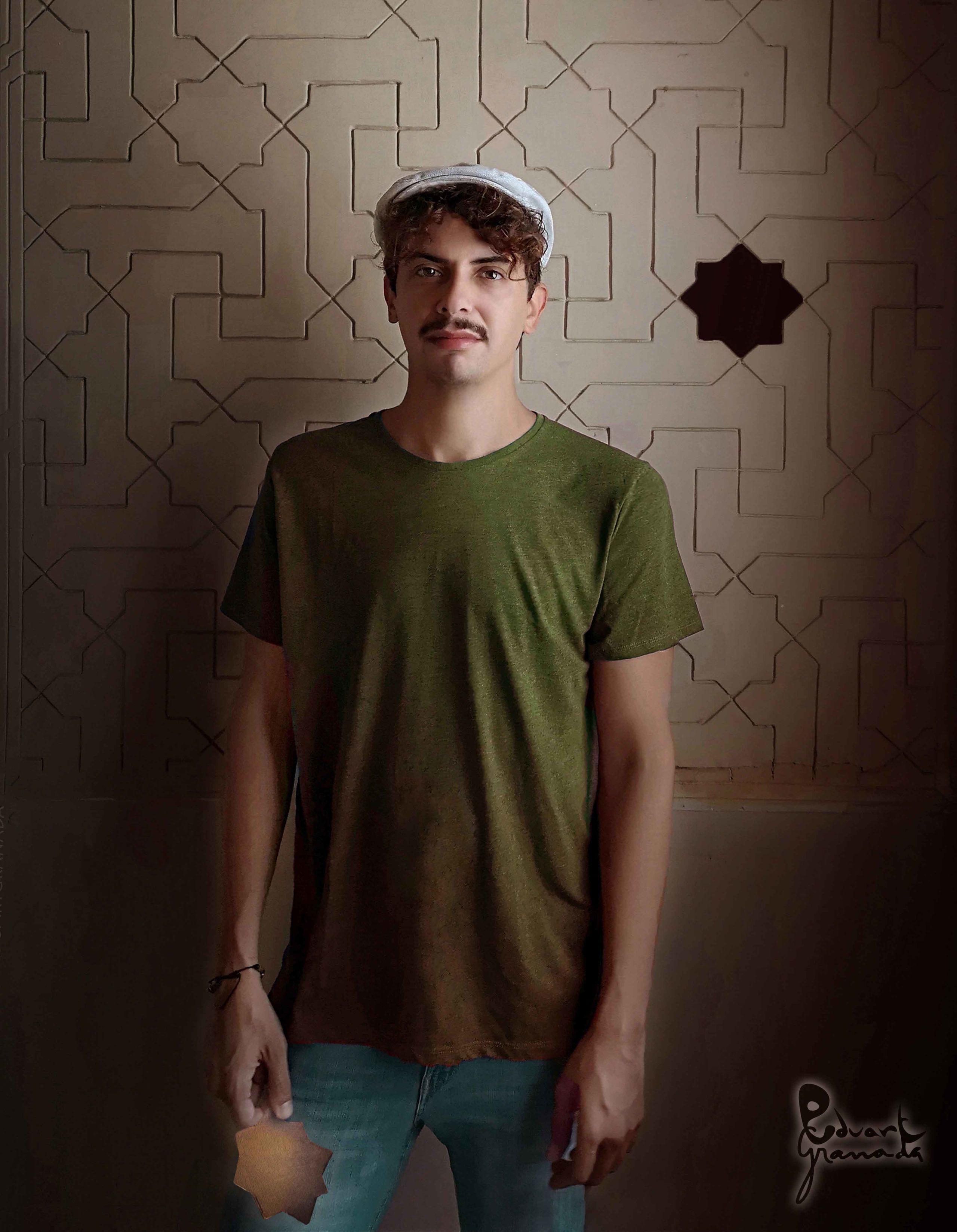
Awareness of the legacy of Al-Andalus grows ever stronger in Spain, as exemplified in the work of artists such as Eduardo Gorlat, pictured here.
Spanish Arabism, he added, “has never before had such a large number of scholars and such a large number of published works and cultural activities related to Al-Andalus.”
The next step toward recovering the full complexity of Spain’s true identity should be that “this enormous contribution reaches more layers of society and enters schools, institutes and the media in a more comprehensive and systematic way.
“I am one of those who think that the Arabic language should be offered as an optional second language in Spanish schools in many regions, both to better understand our past and to establish better ties with current Arab countries.”
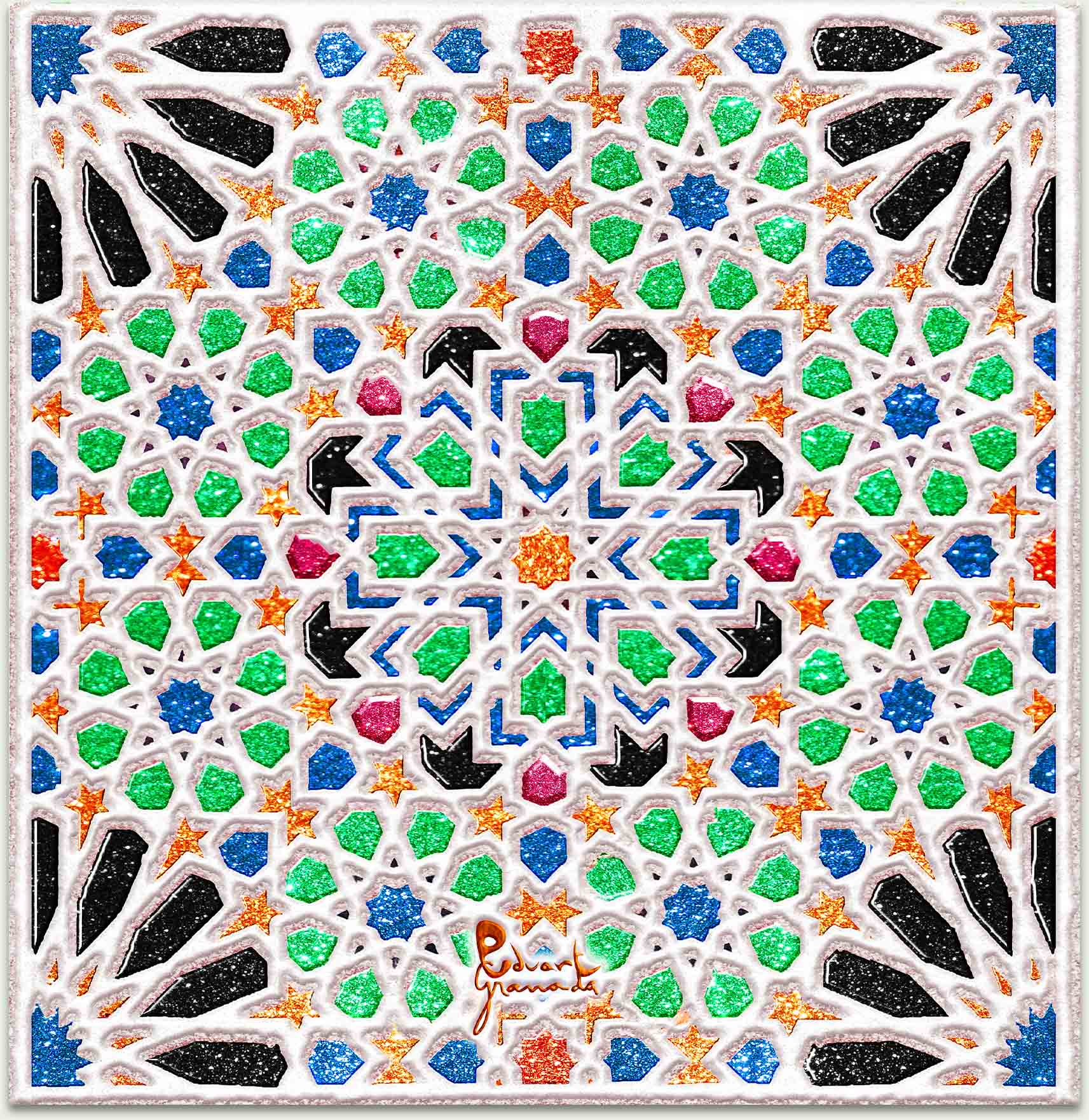
“Alhambra Poptile,” by artist Eduardo Gorlat, bridges old and new.
For Dr. Antonio de Diego, professor of political philosophy at the University of Pablo de Olavide, Seville, and a vice-president of the Spanish Islamic Board, “the Andalusian influence in Granada can be appreciated in a large number of aspects.”
“You cannot really understand Spain without the Islamic substrate,” he said.
But Spanish historian Manzano is less optimistic.
“Today’s Spaniards are unfortunately very ignorant of the Andalusian past,” he said. “Notwithstanding the fact that lots of public resources have been devoted to the study of the legacy of Al-Andalus in the past 30 years, we have not been able to convey to the general public the richness and importance of this period.
“Many misunderstandings, myths and manipulations still prevail, as witnessed by the extension of extreme-right misconceptions about the medieval period.
“This is unfortunate for those of us who consider that serious knowledge of Al-Andalus might contribute to the mutual understanding, respect and appreciation of cultures that nowadays is more necessary than ever.”

Cyrine Sanchou, center, with her parents, husband and three children, are among the last of the Andalusians. They live in Tunisia but have visited Spain.
Cyrine Sanchou, center, with her parents, husband and three children, are among the last of the Andalusians. They live in Tunisia but have visited Spain.

An engraving depicts Muslims expelled from Spain by King Philip III. (Getty Images)
An engraving depicts Muslims expelled from Spain by King Philip III. (Getty Images)

Cyrine Sanchou’s family has a copy of the original bill of sale for “Sancho’s house” back in Spain, now a partial ruin. (Supplied)
Cyrine Sanchou’s family has a copy of the original bill of sale for “Sancho’s house” back in Spain, now a partial ruin. (Supplied)

The Great Mosque of Granada, built with funding from the UAE and Morocco in 2003, was the first mosque to open in the area since the fall of Al-Andalus. (Getty Images)
The Great Mosque of Granada, built with funding from the UAE and Morocco in 2003, was the first mosque to open in the area since the fall of Al-Andalus. (Getty Images)

Amal Correon, right, travels to Hornachos from Rabat every year. Here he is with Mayor Francisco Buenavista. (Supplied)
Amal Correon, right, travels to Hornachos from Rabat every year. Here he is with Mayor Francisco Buenavista. (Supplied)

Following the order by Philip III in 1609 to expel Muslims from Spain, the entire population of Hornachos was evicted. (Supplied)
Following the order by Philip III in 1609 to expel Muslims from Spain, the entire population of Hornachos was evicted. (Supplied)

Amal Correon has a document from 1614 showing the name of his ancestor, Garcia Correon, who took charge of 500 widows and their children. (Supplied)
Amal Correon has a document from 1614 showing the name of his ancestor, Garcia Correon, who took charge of 500 widows and their children. (Supplied)

Awareness of the legacy of Al-Andalus grows ever stronger in Spain, as exemplified in the work of artists such as Eduardo Gorlat, pictured here.
Awareness of the legacy of Al-Andalus grows ever stronger in Spain, as exemplified in the work of artists such as Eduardo Gorlat, pictured here.

“Alhambra Poptile,” by artist Eduardo Gorlat, bridges old and new.
“Alhambra Poptile,” by artist Eduardo Gorlat, bridges old and new.
Creditos
Editor: Mo Gannon
Creative director: Simon Khalil
Designer: Omar Nashashibi
Graphics: Douglas Okasaki
Video producer: Eugene Harnan
Video editor: Hassenin Fadhel
Cinematographer: Marcos Rull
Picture researcher: Sheila Mayo
Copy editor: Sarah Mills
Social media: Mohammed Qenan
Producer: Arkan Aladnani
Editor-in-Chief: Faisal J. Abbas
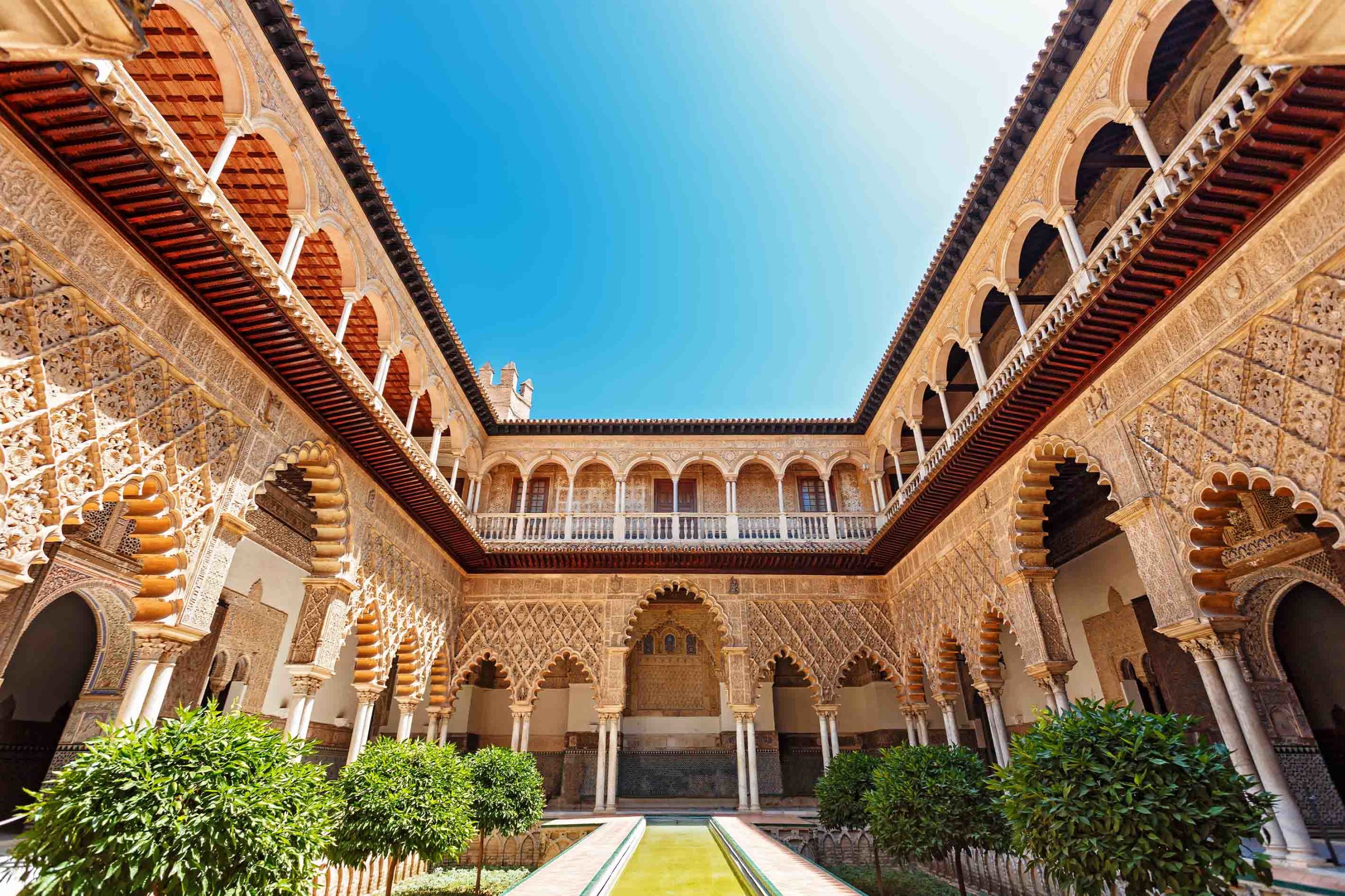
Further reading



